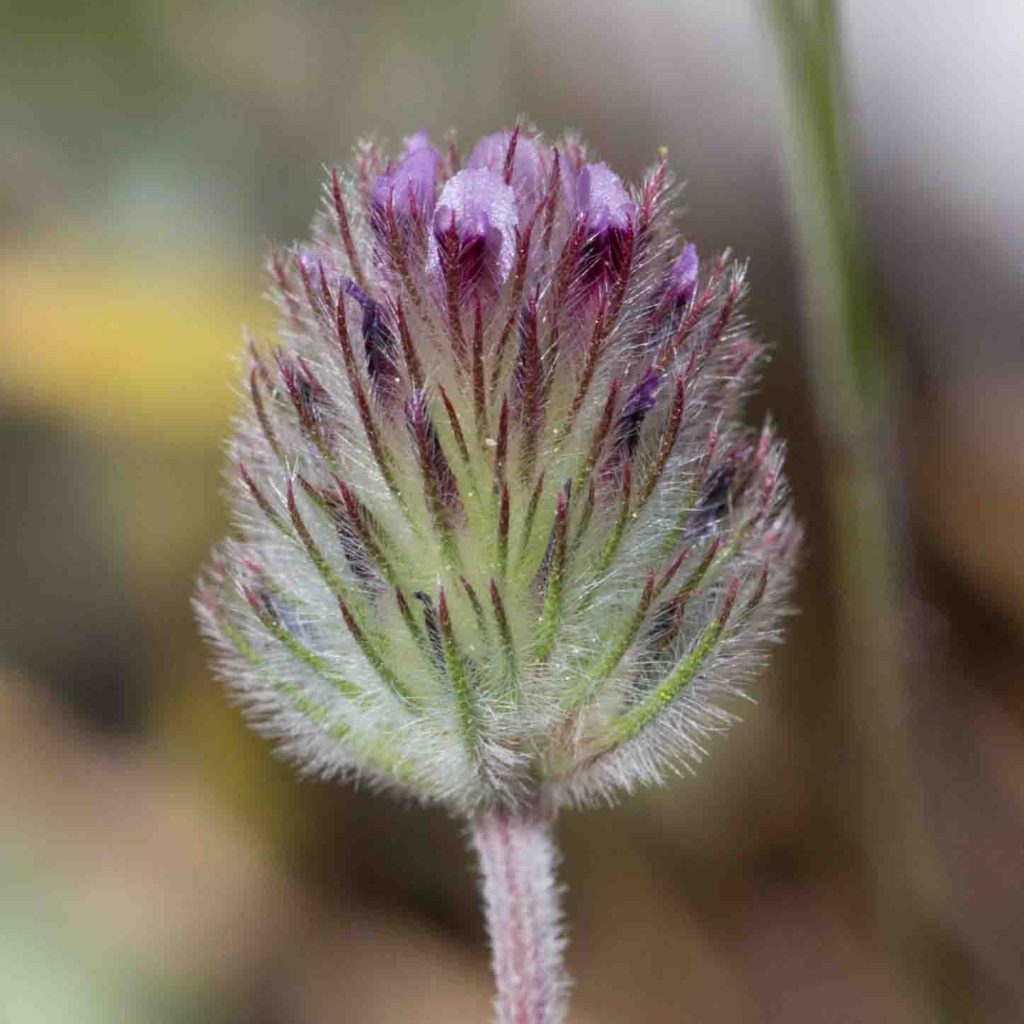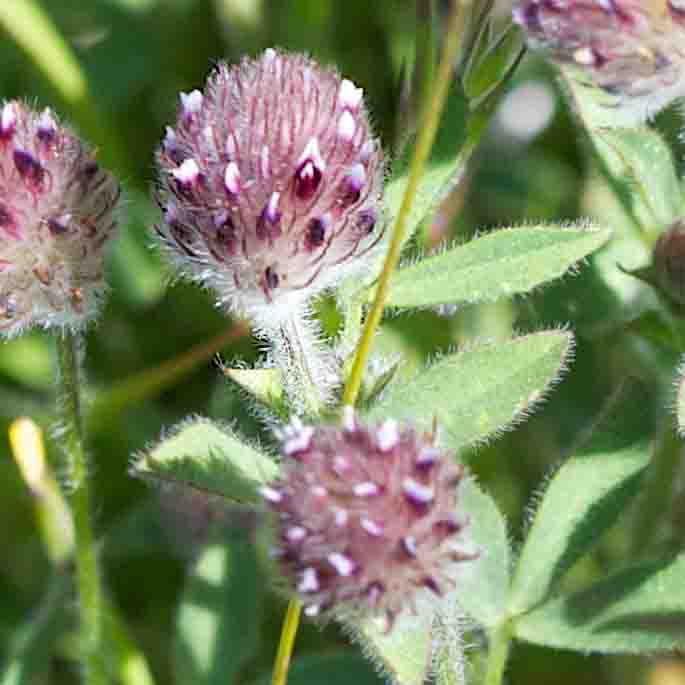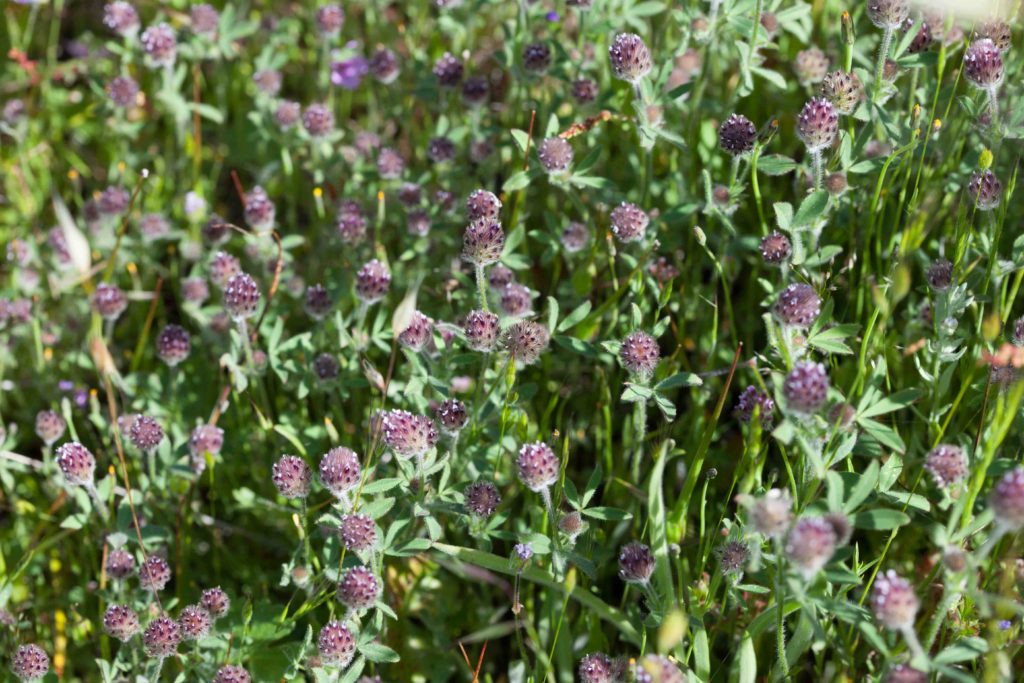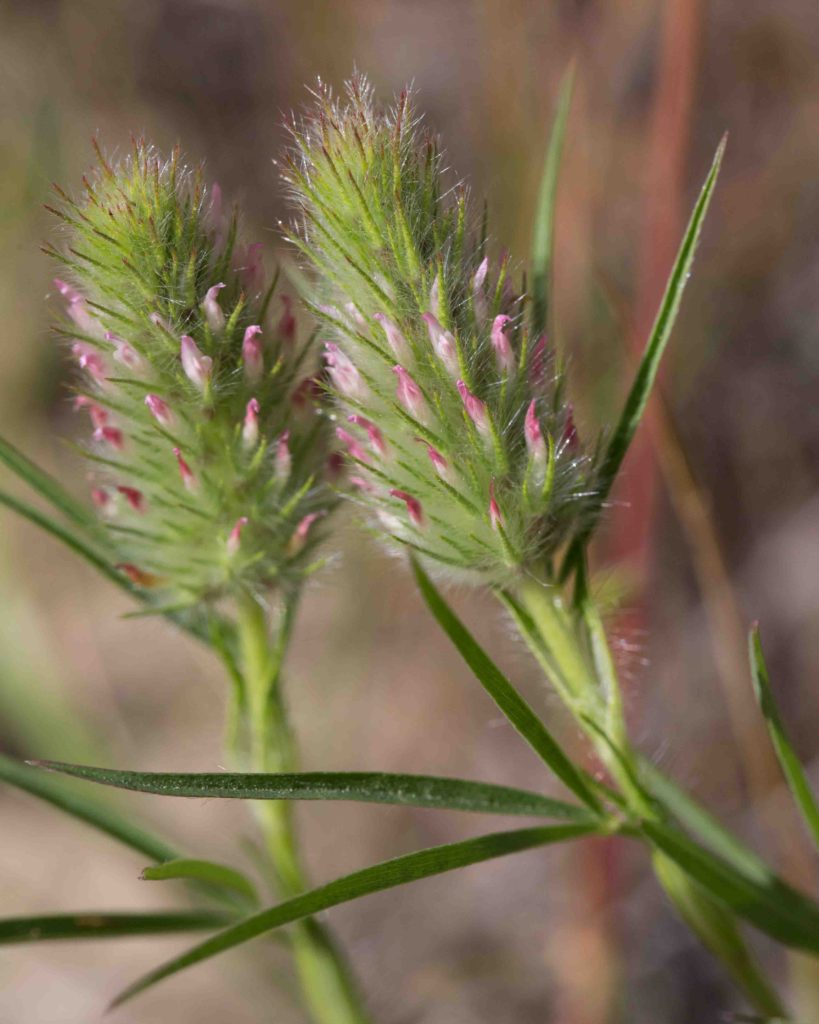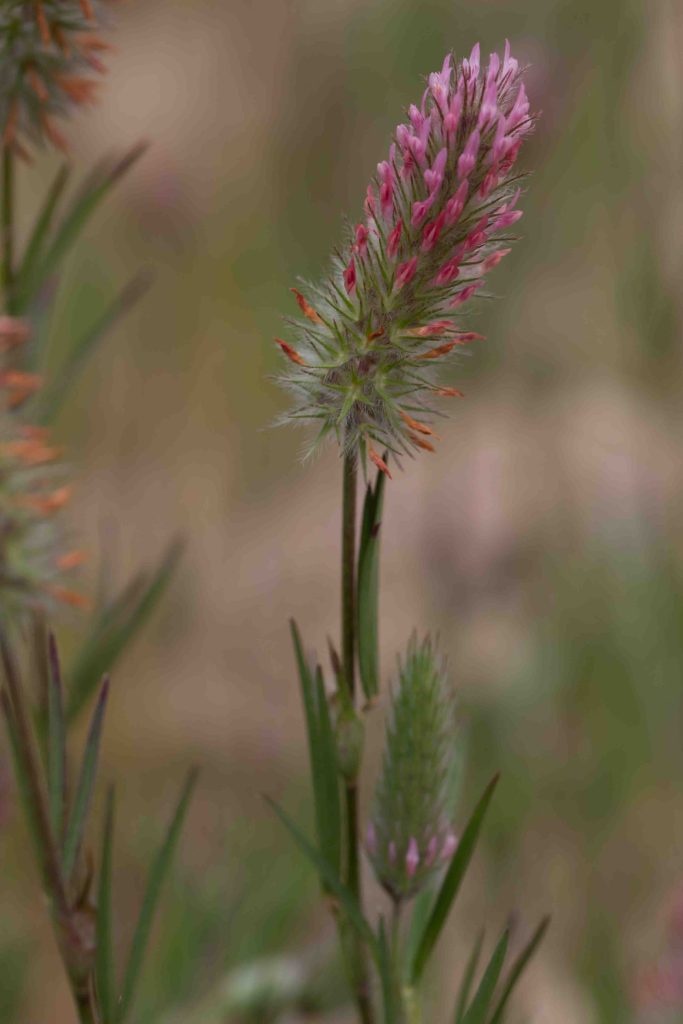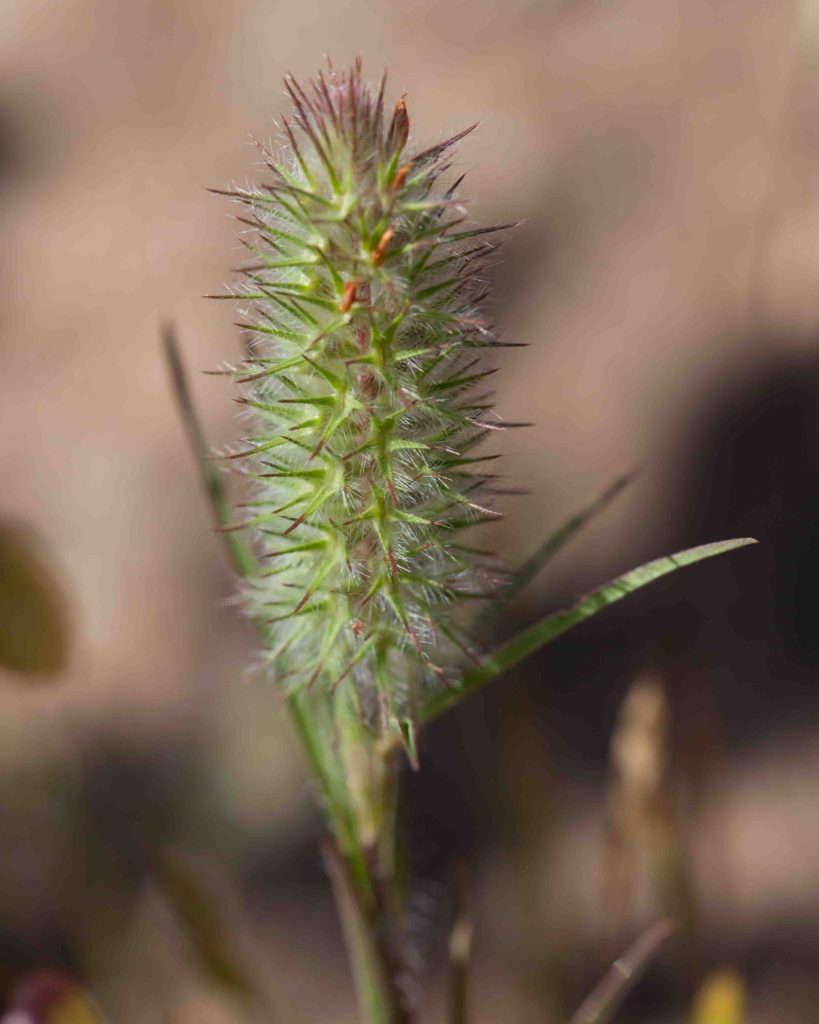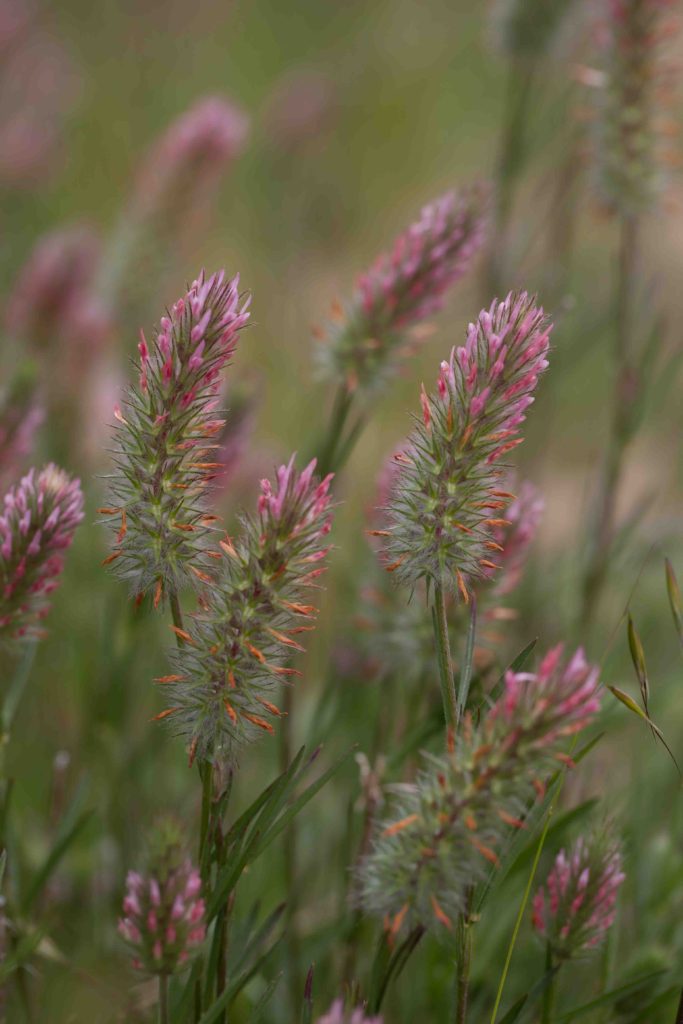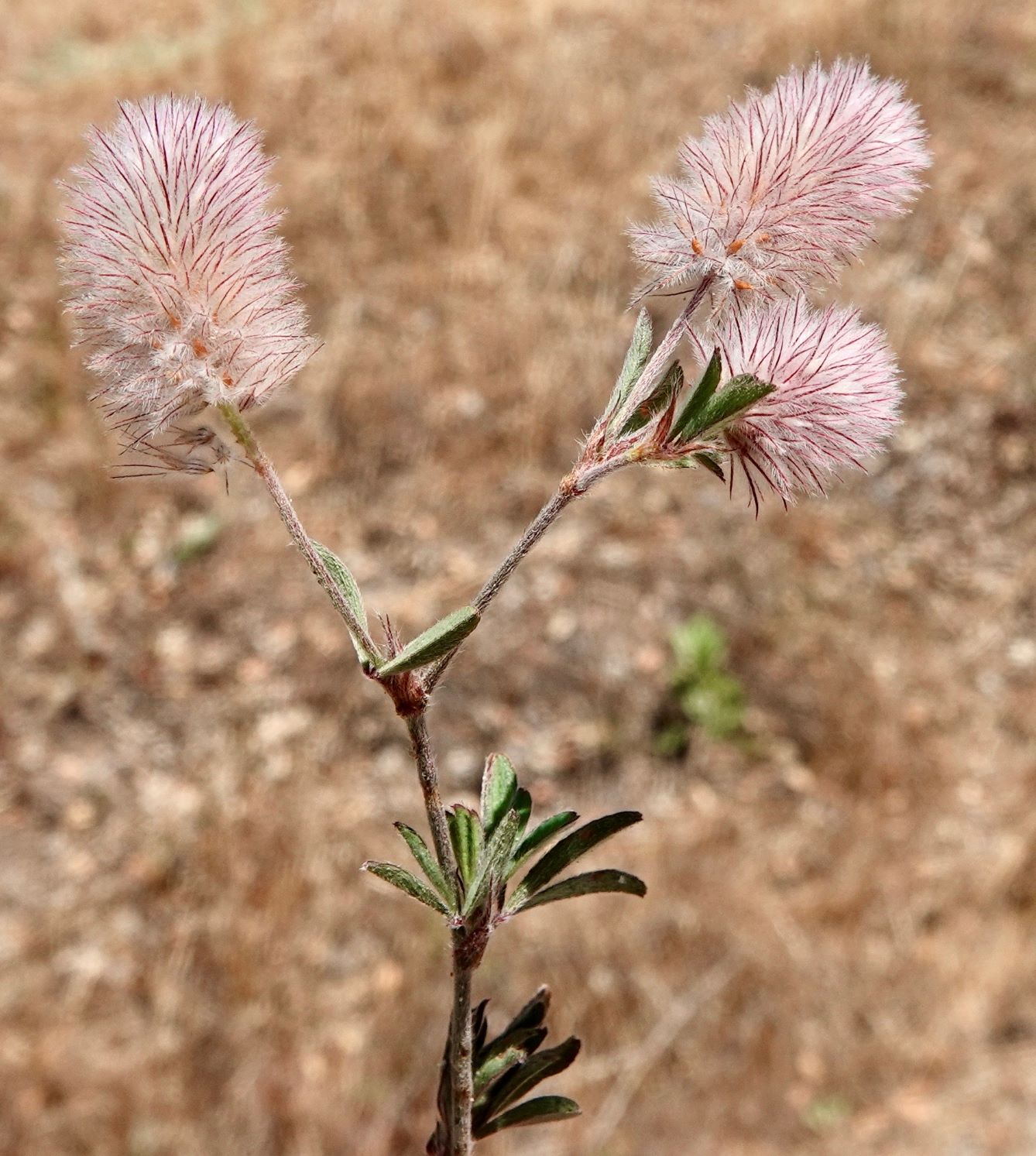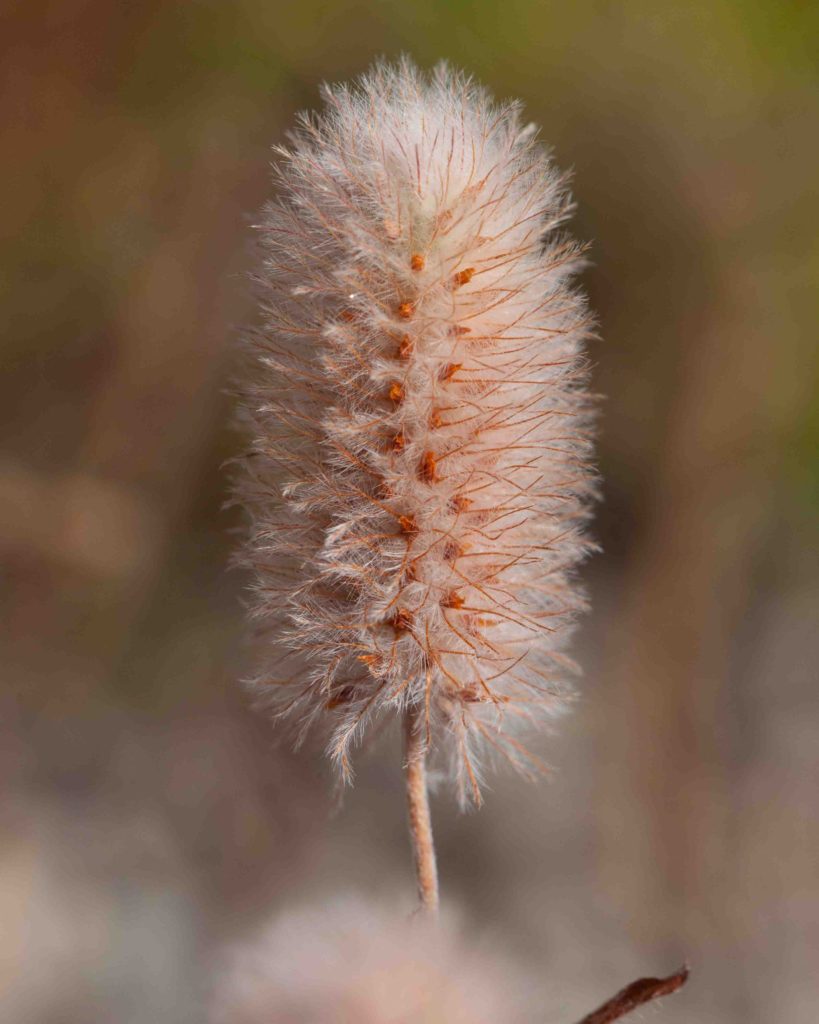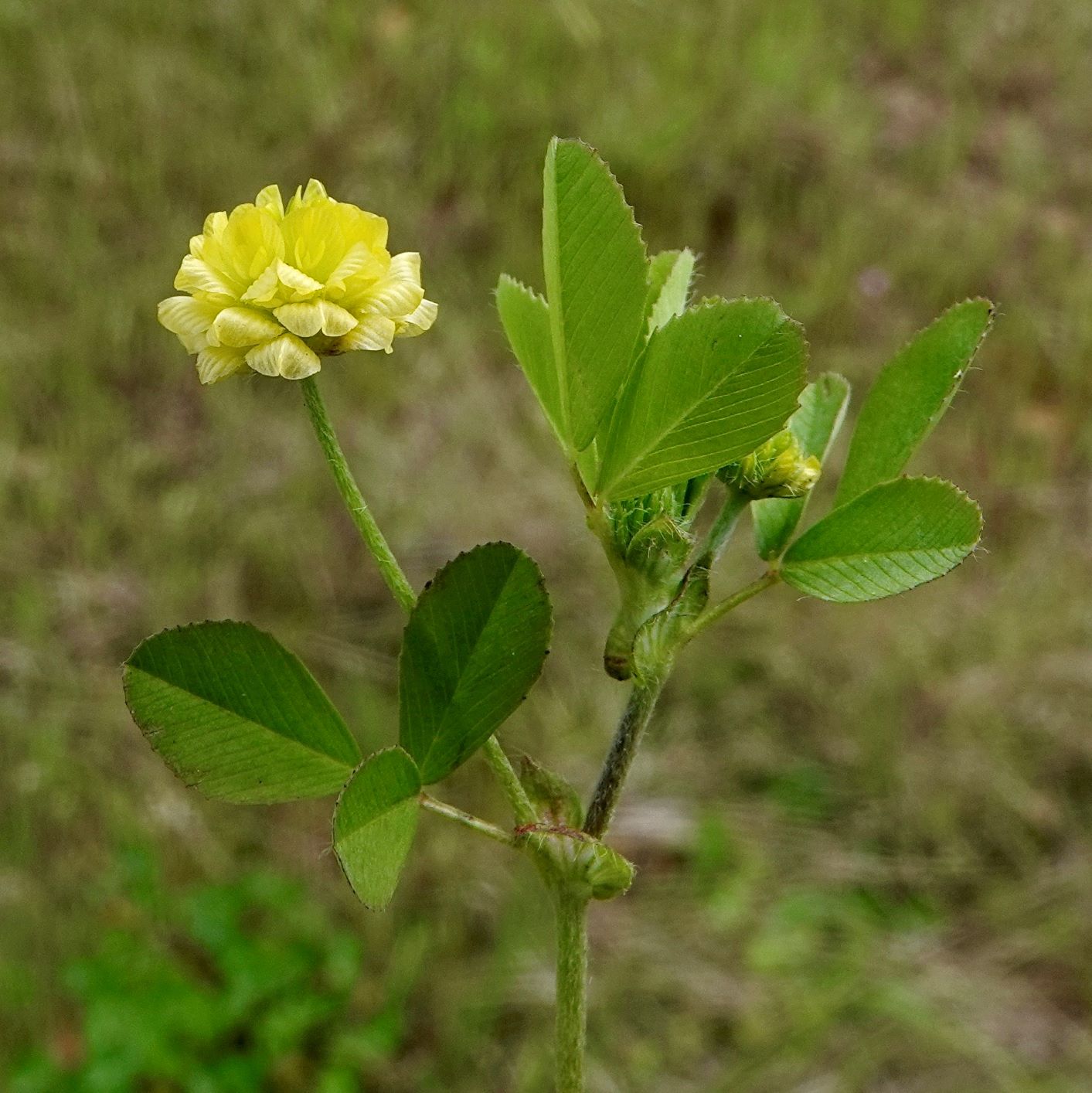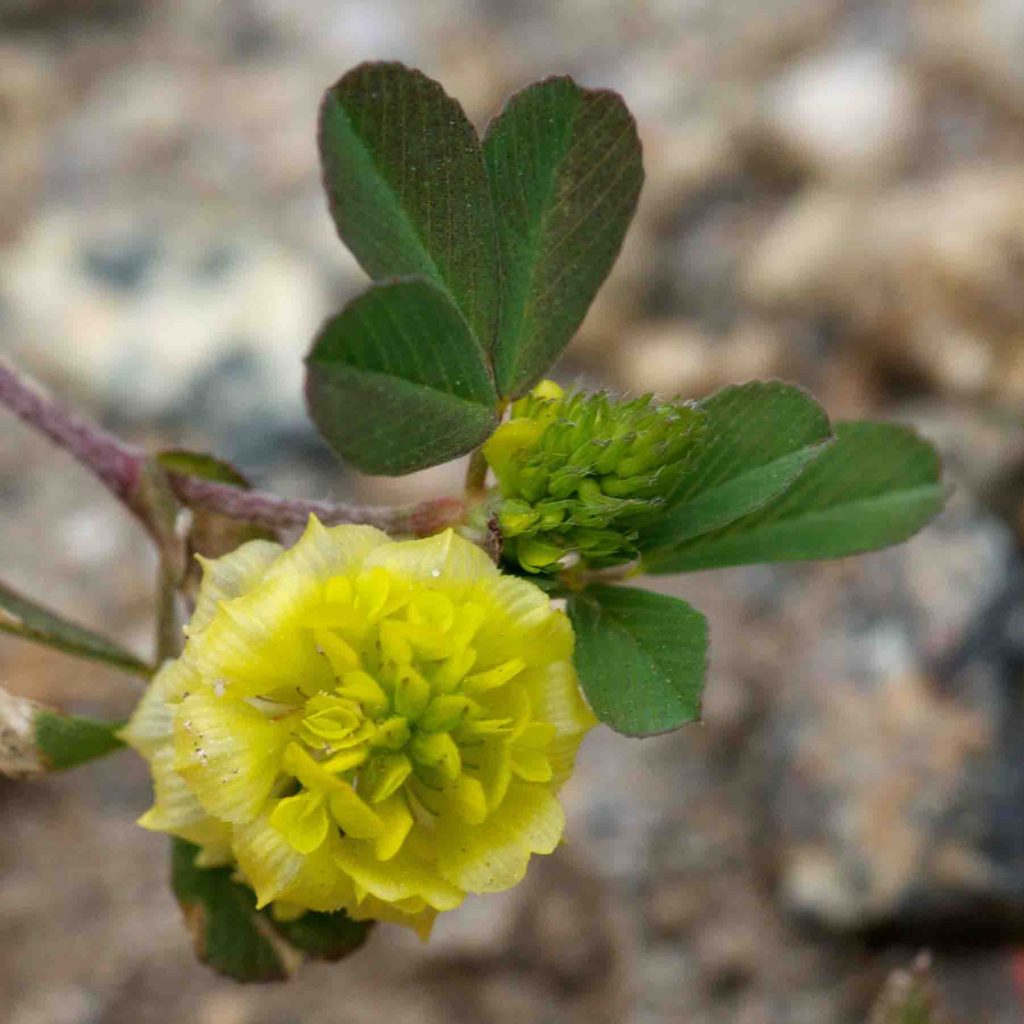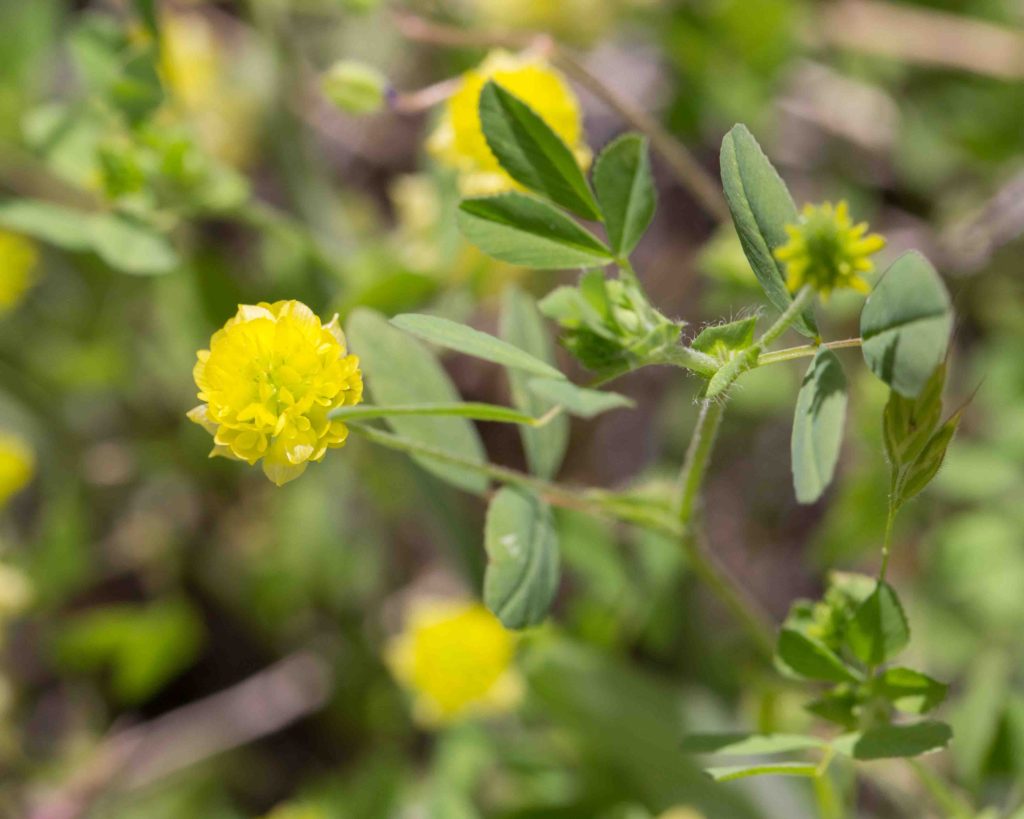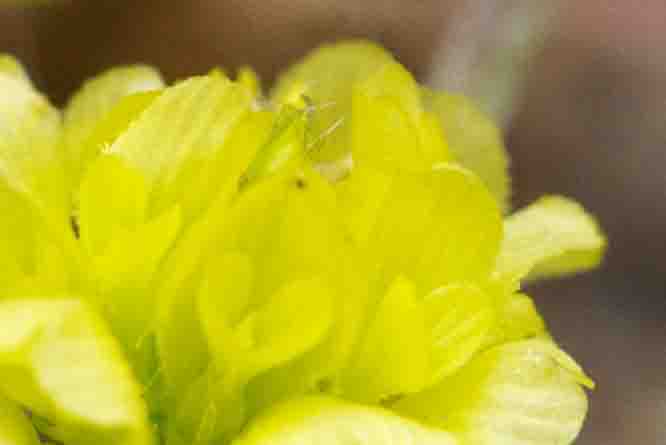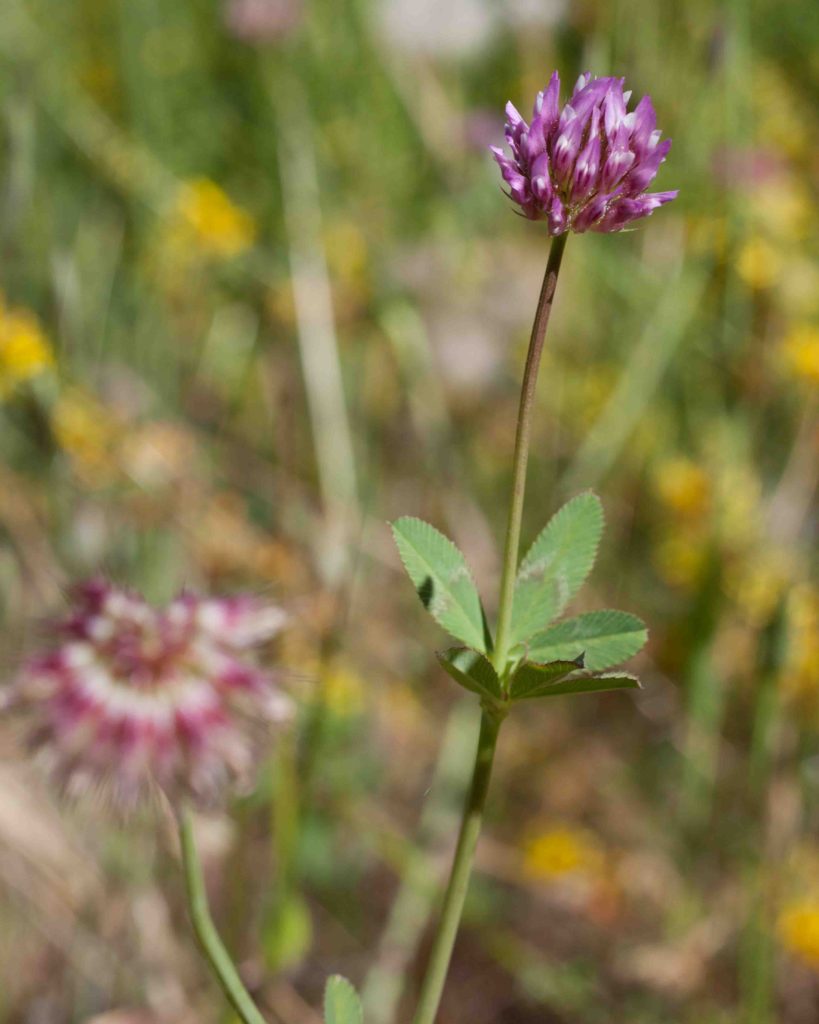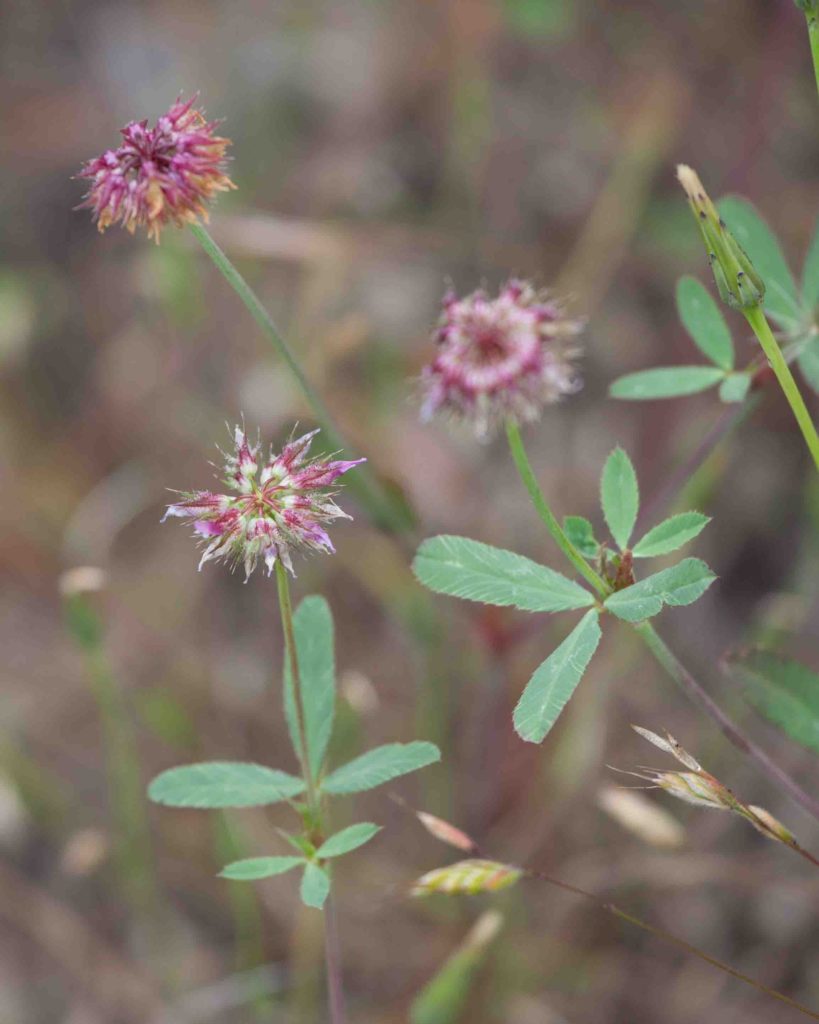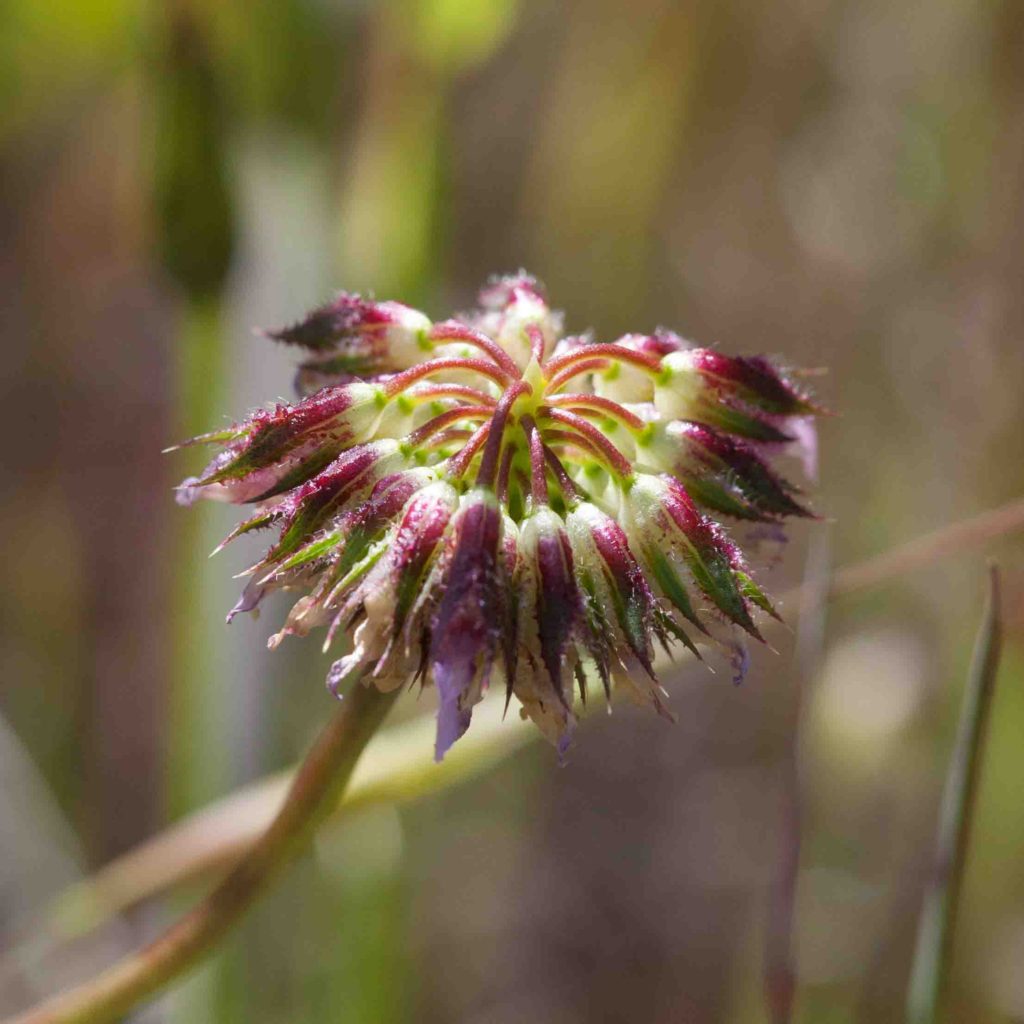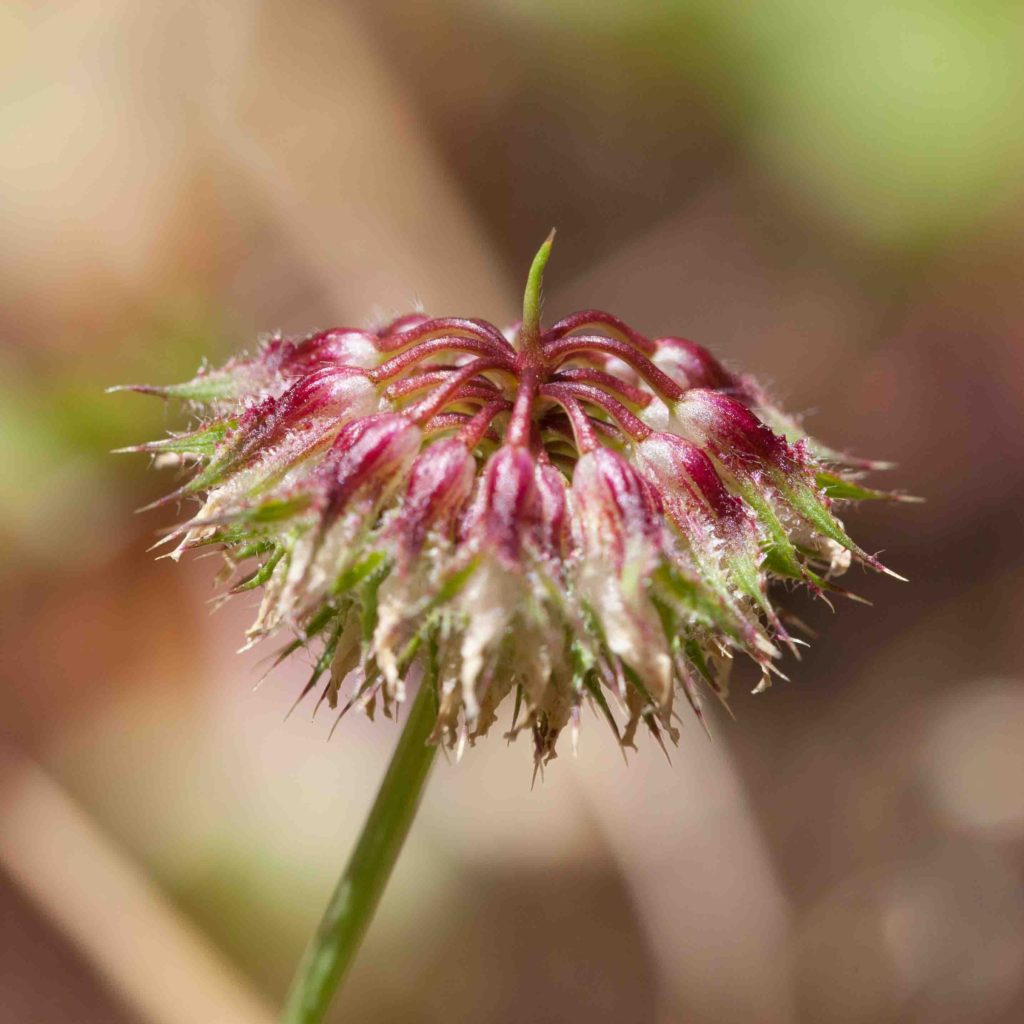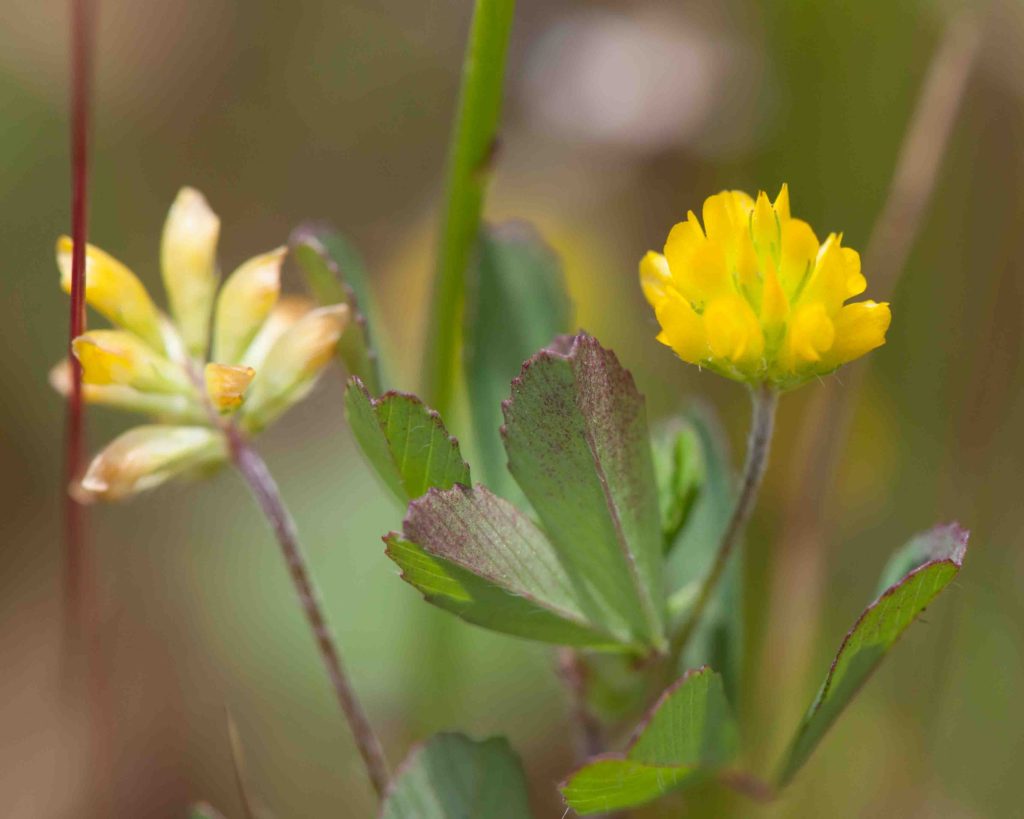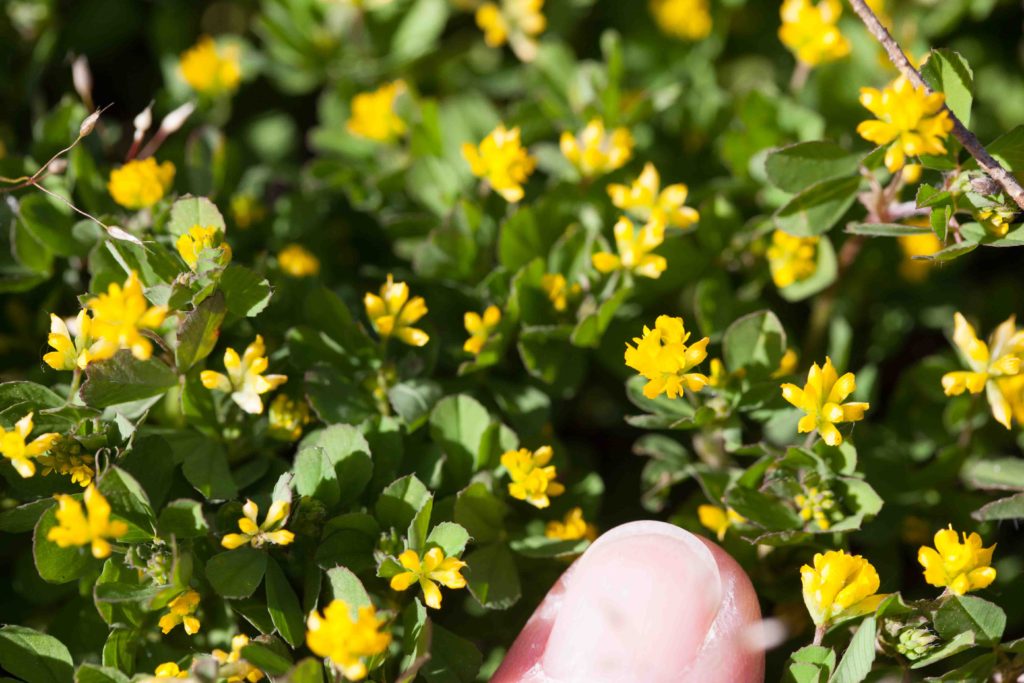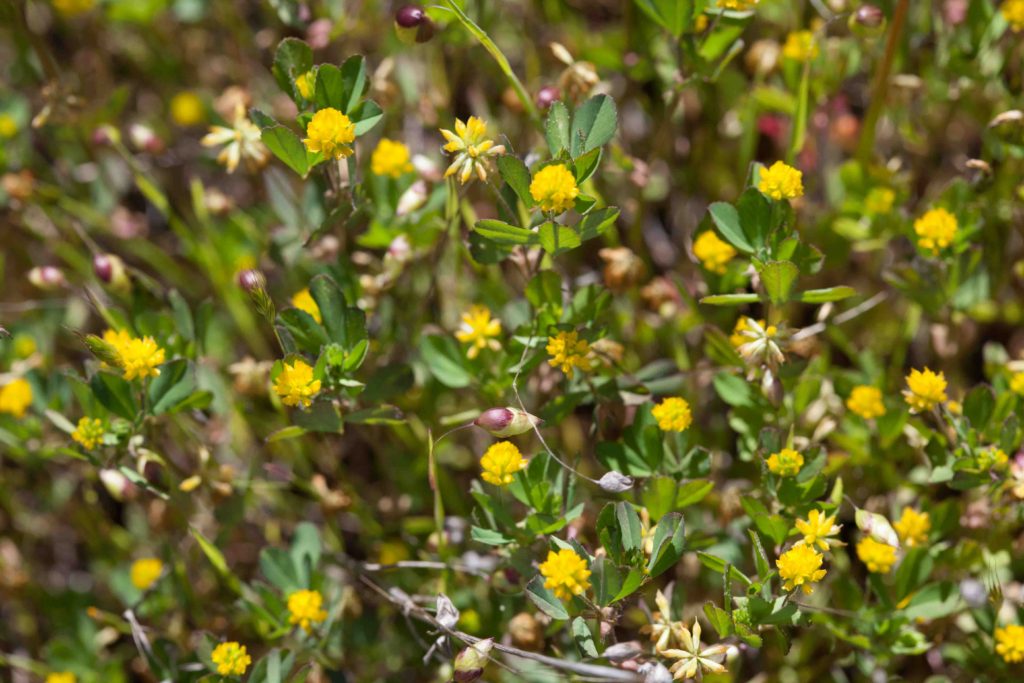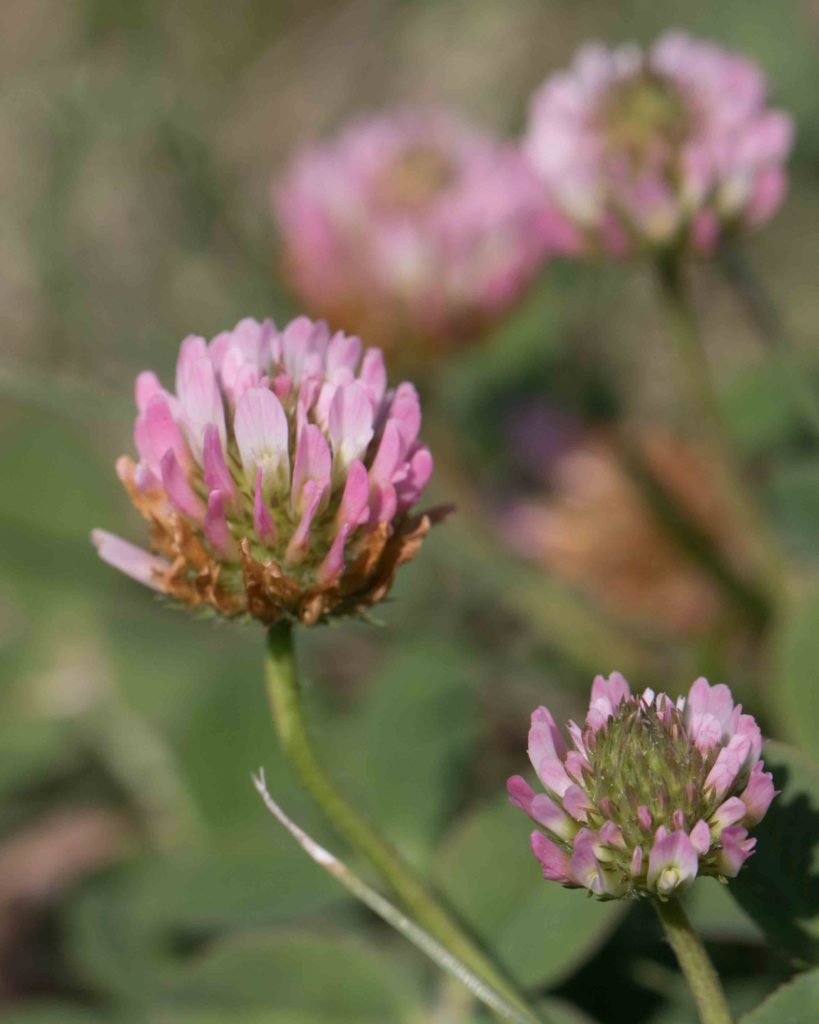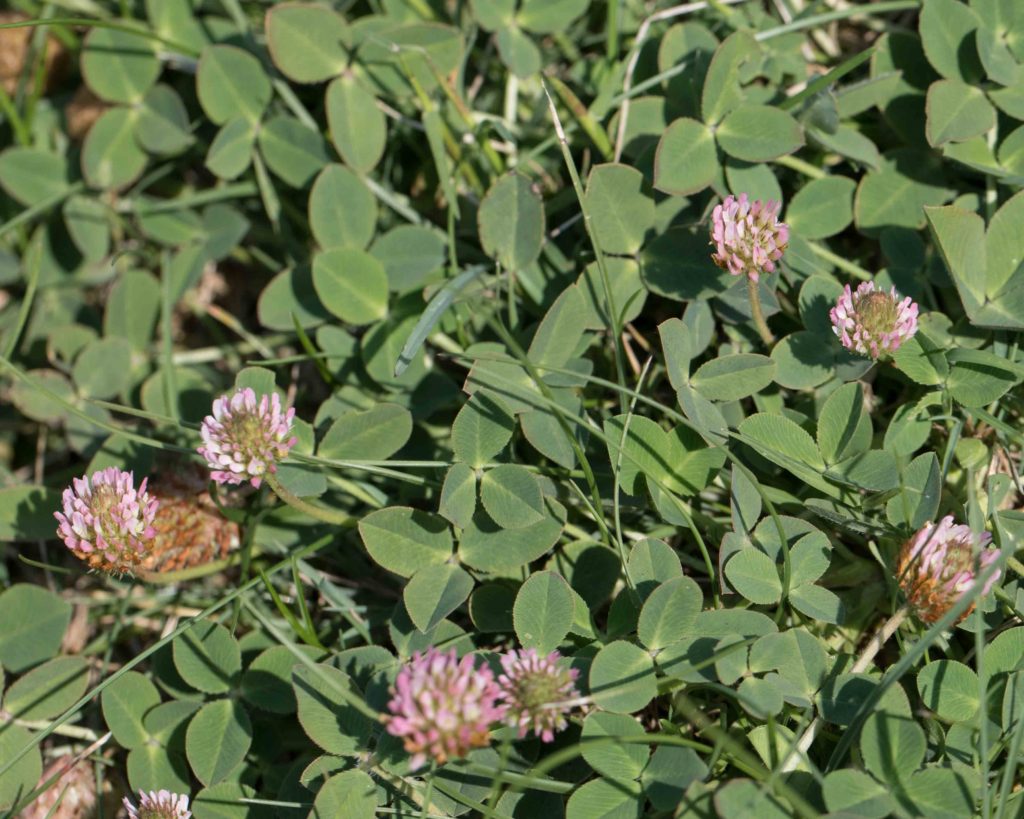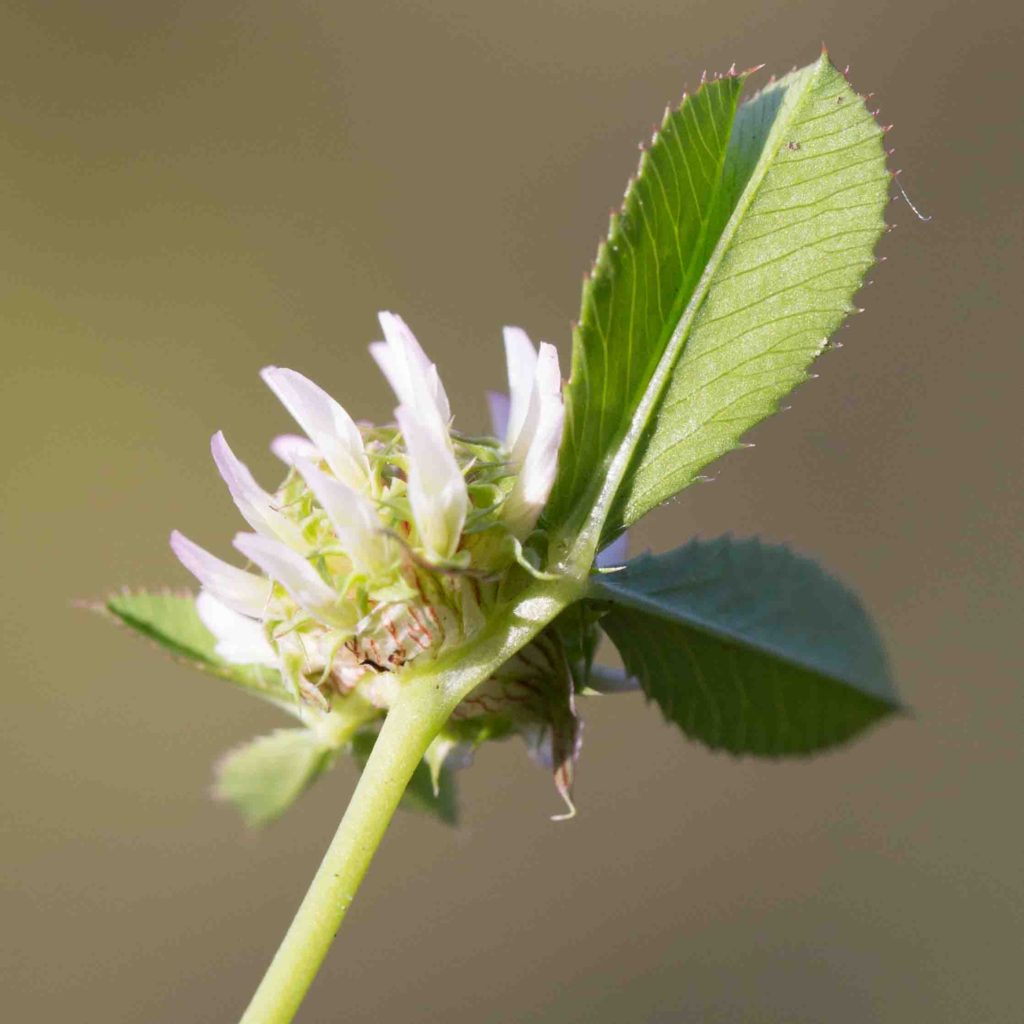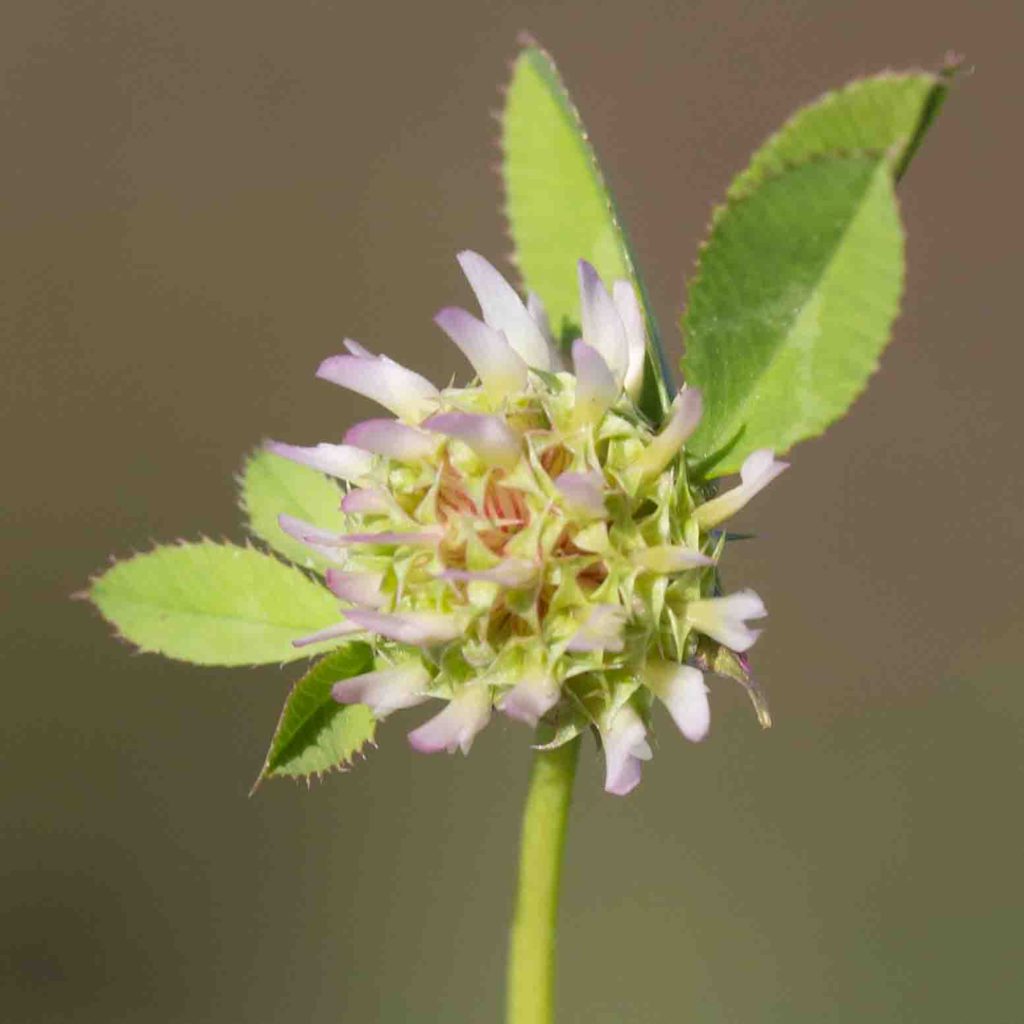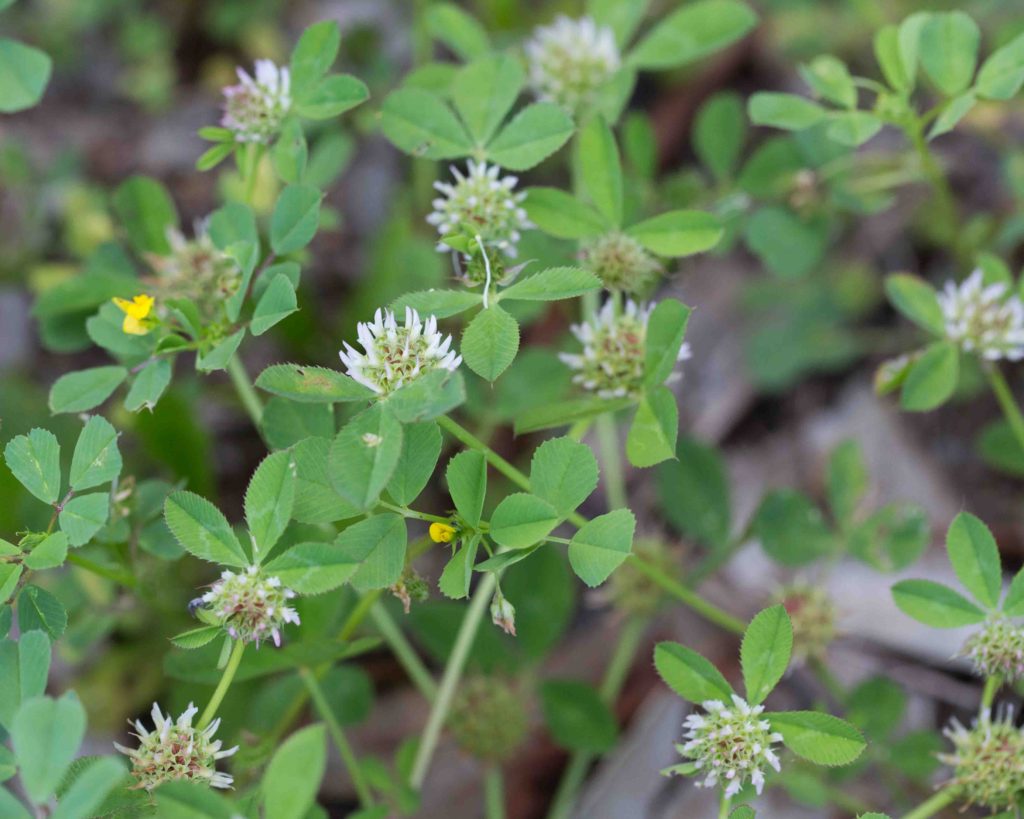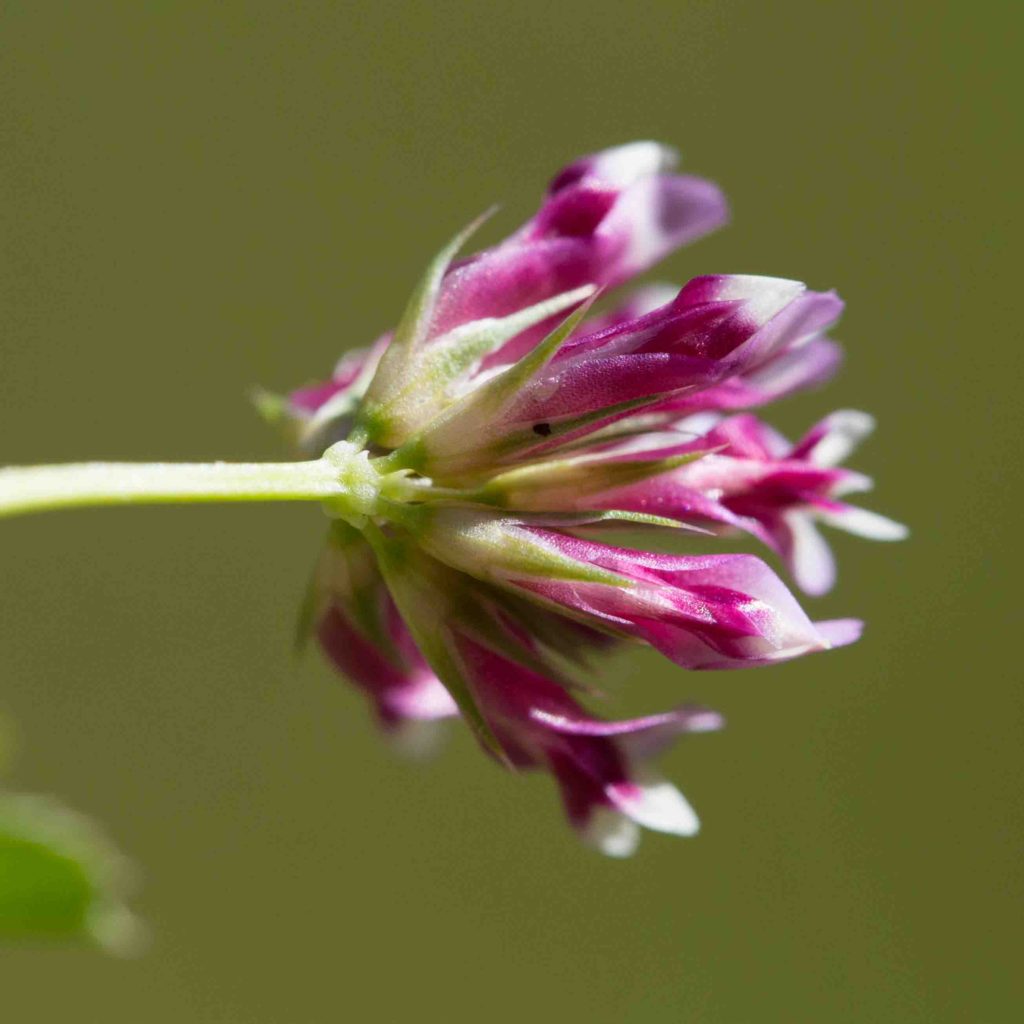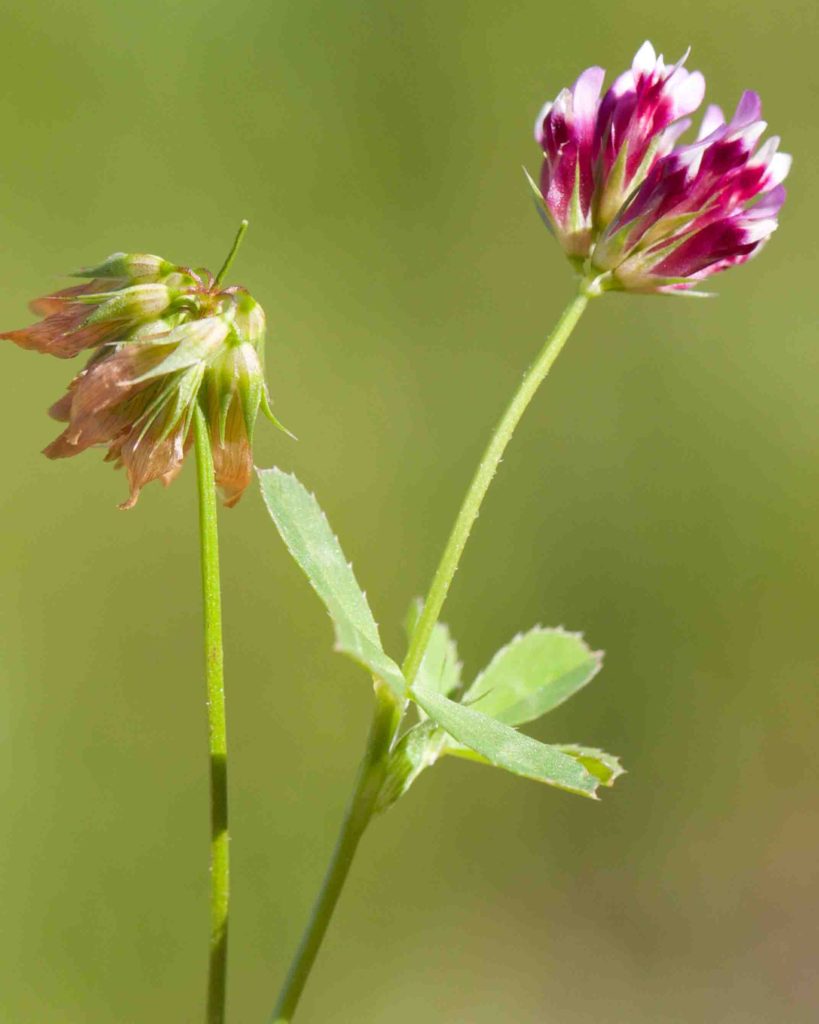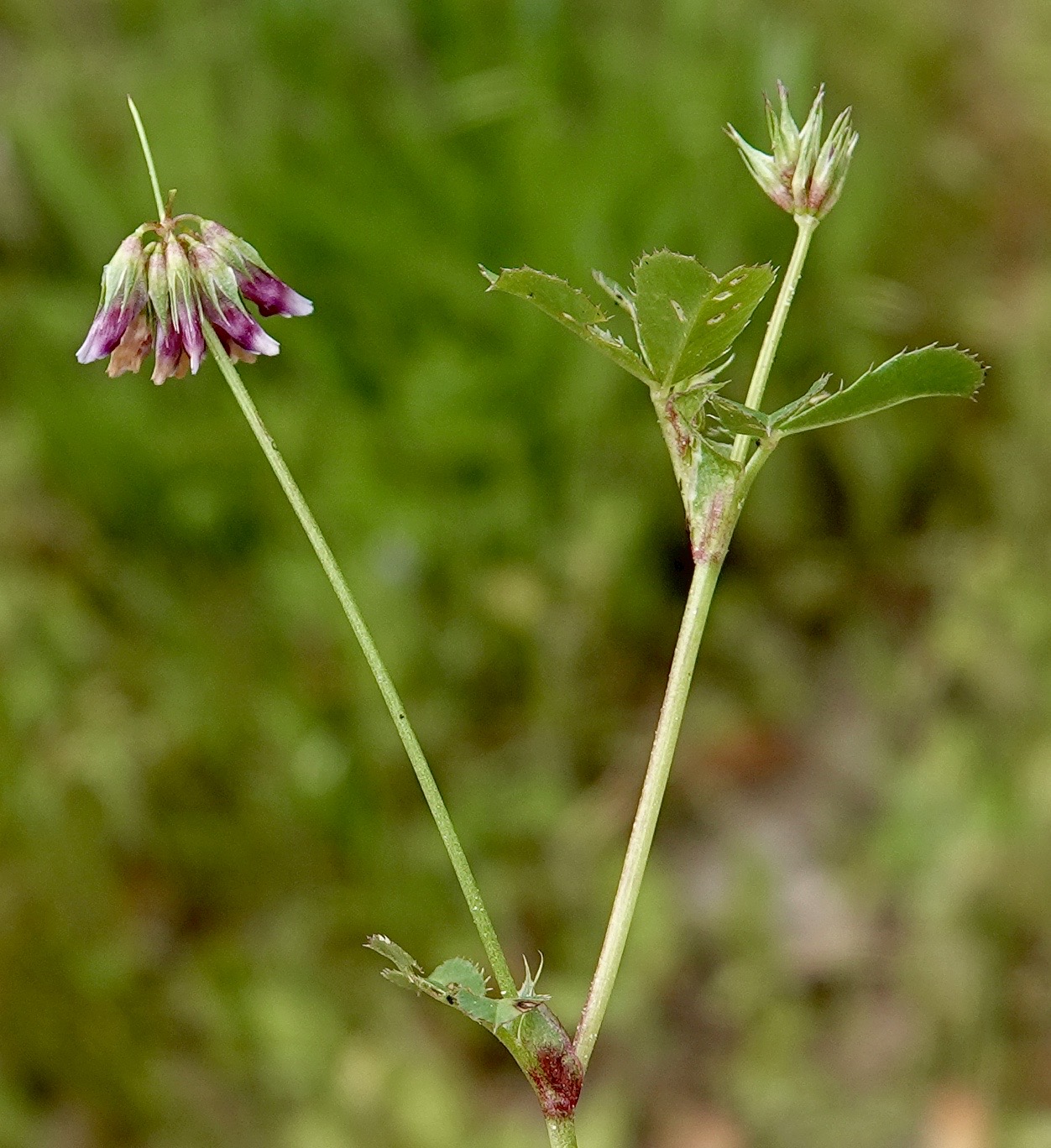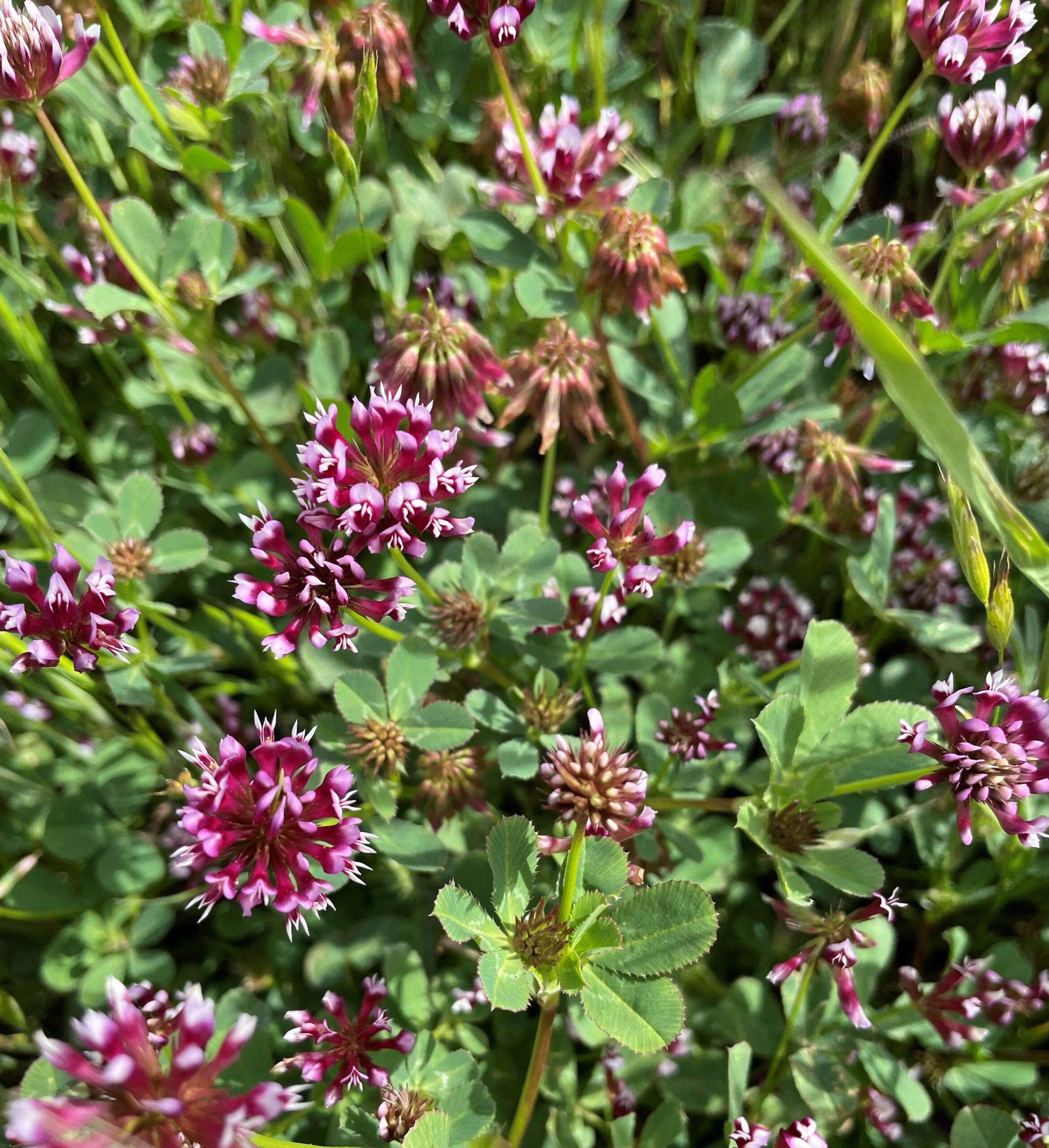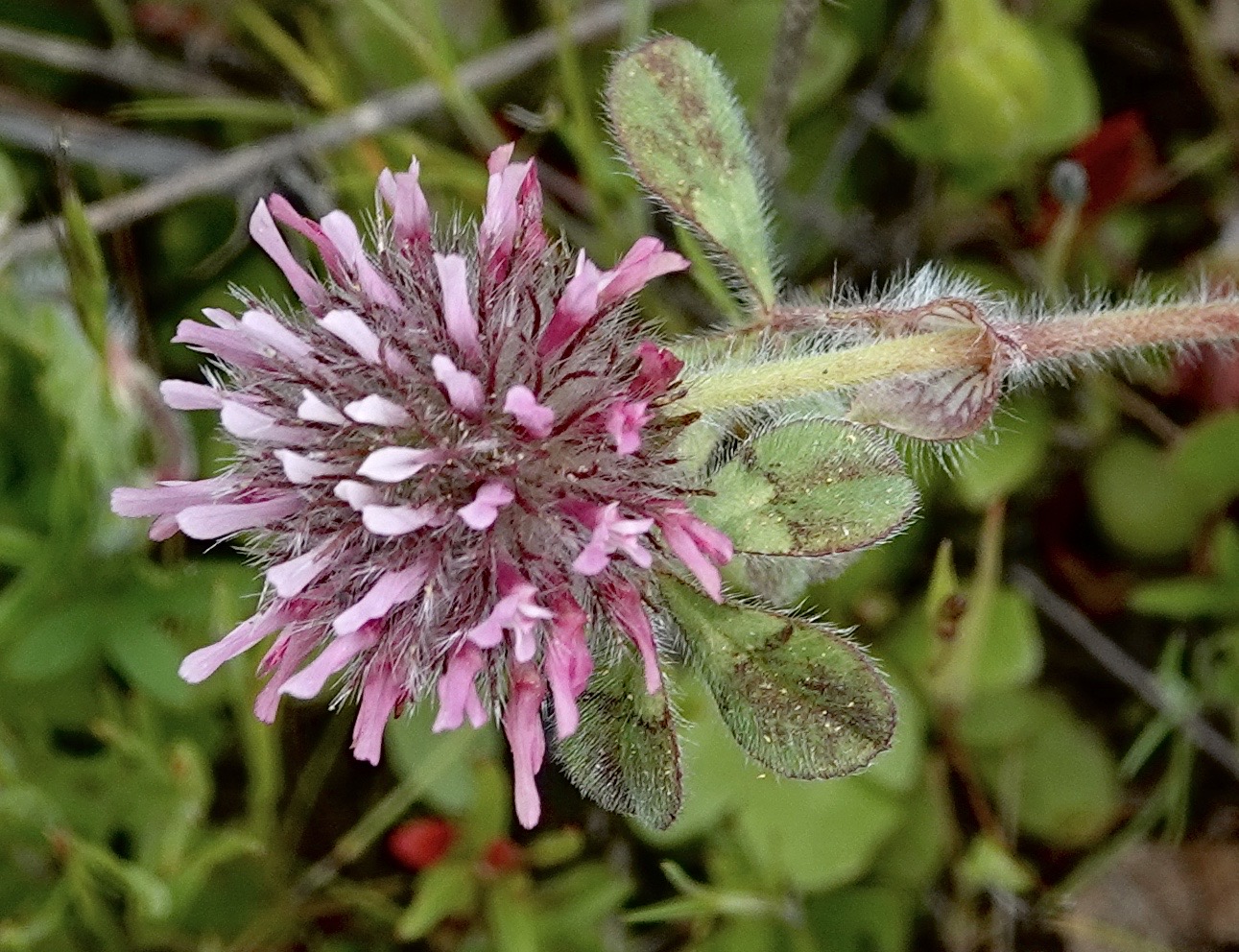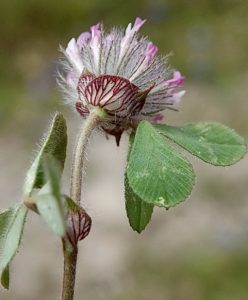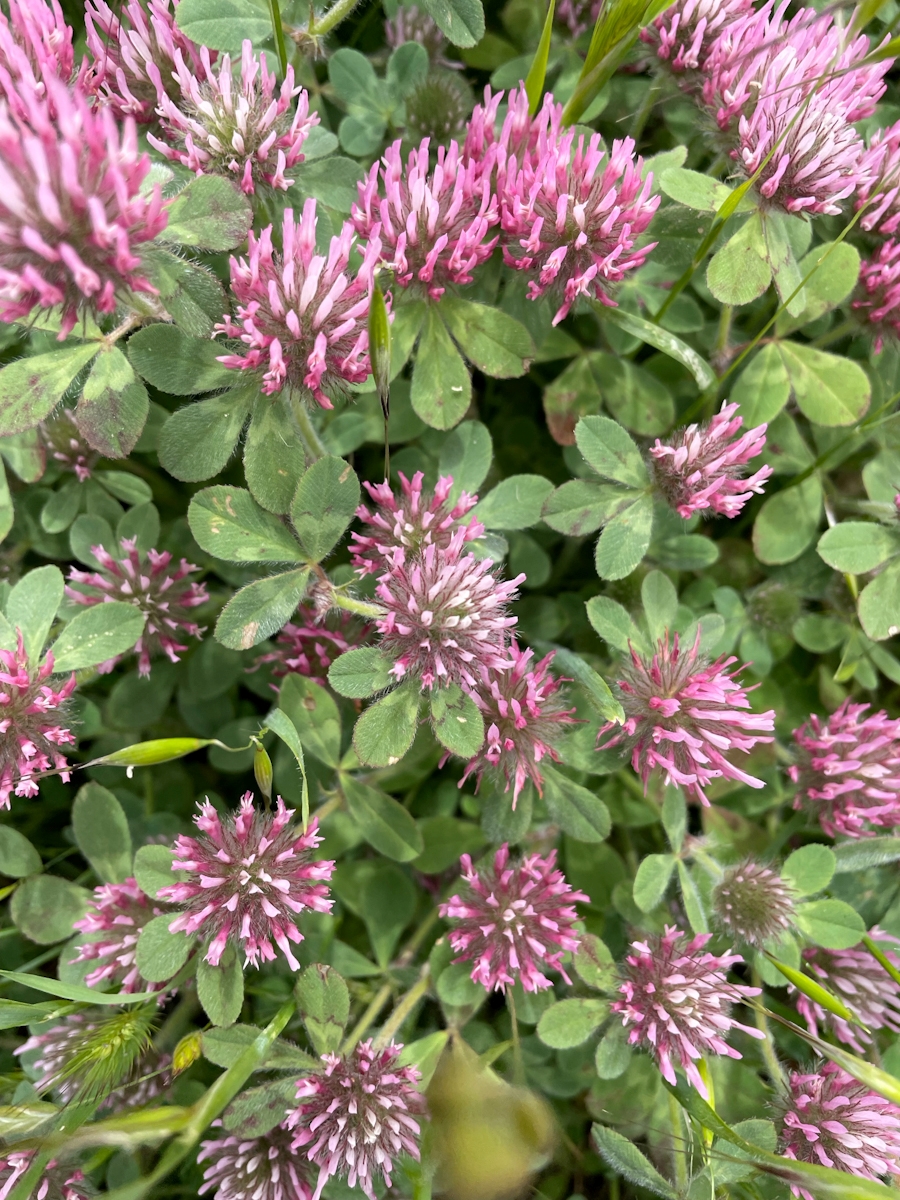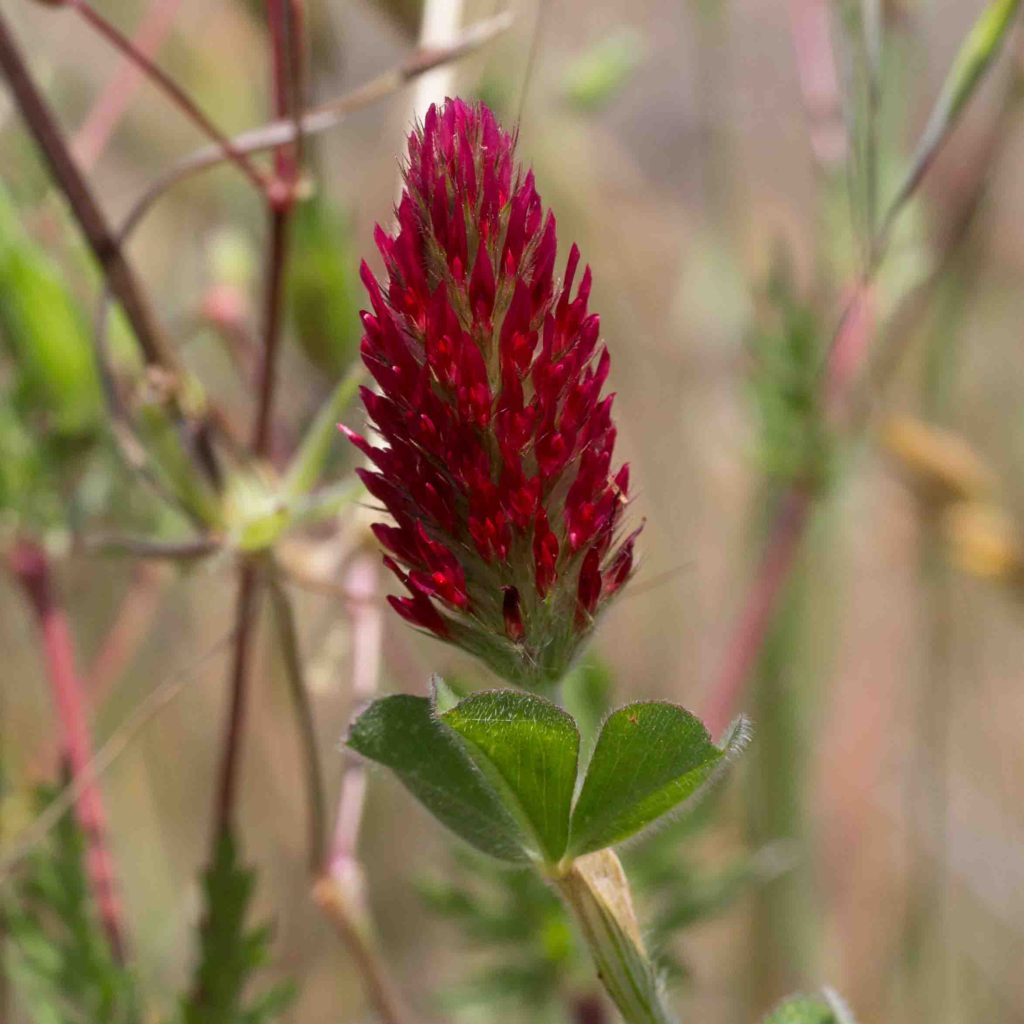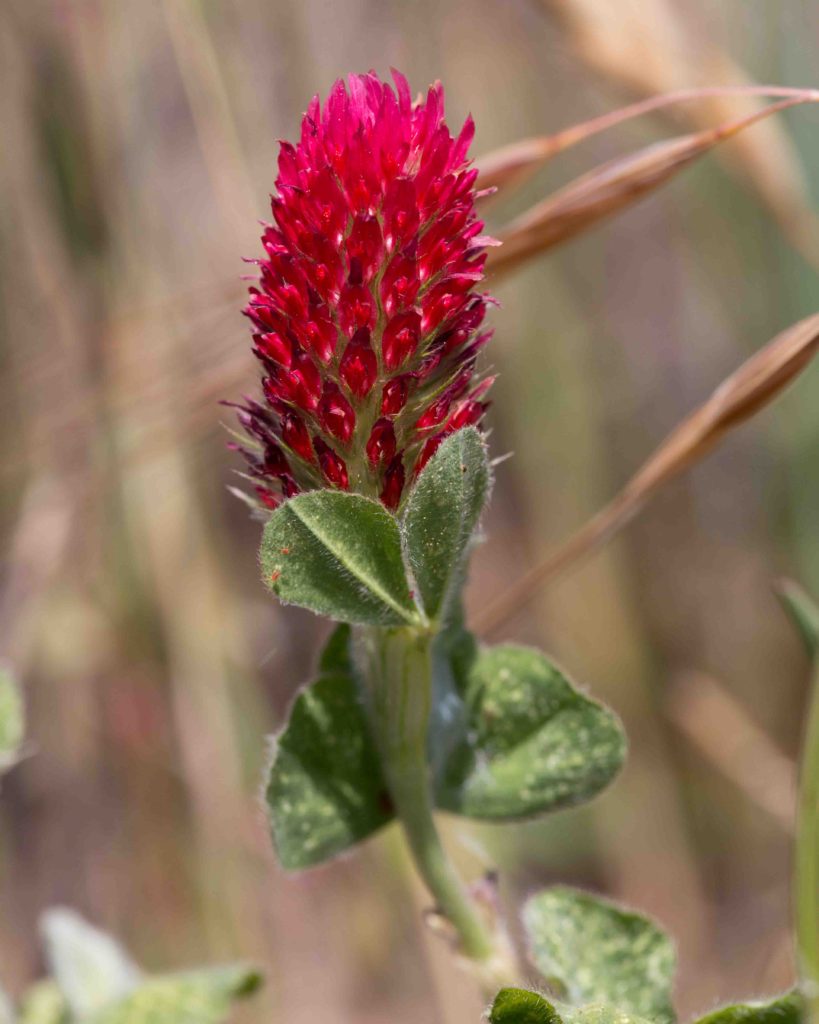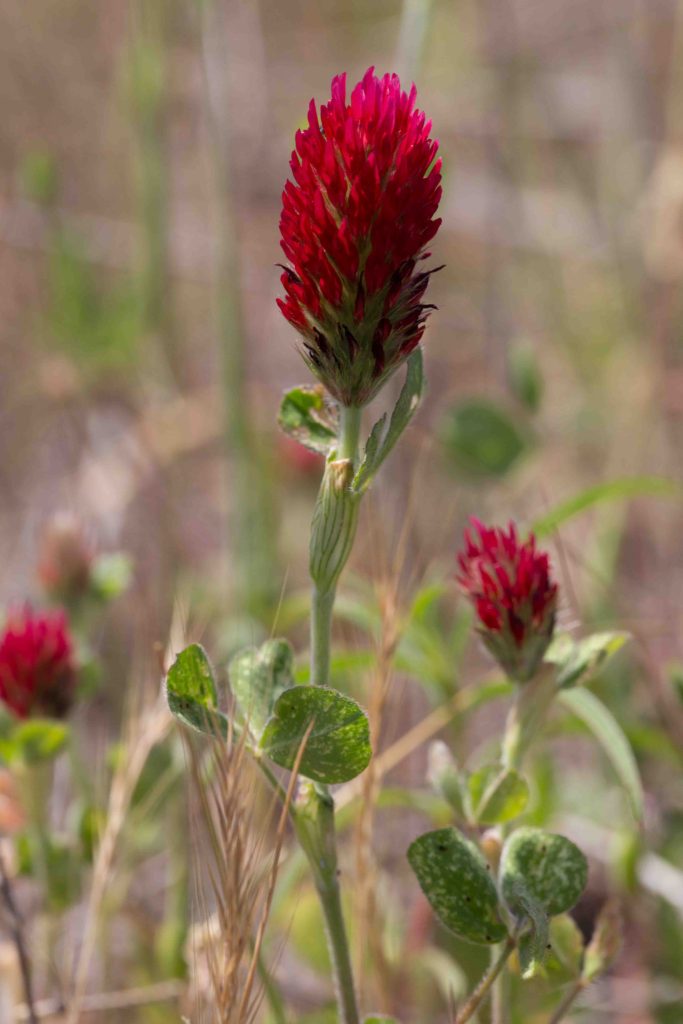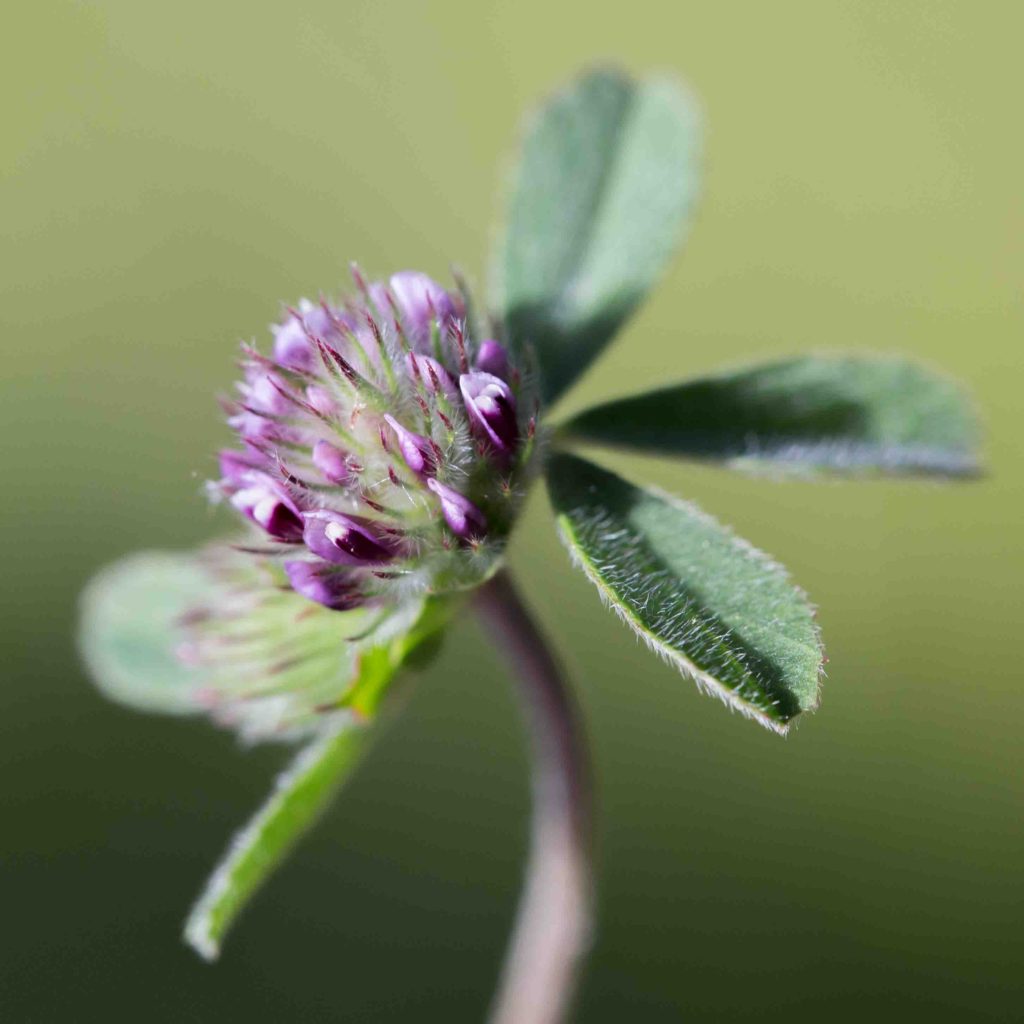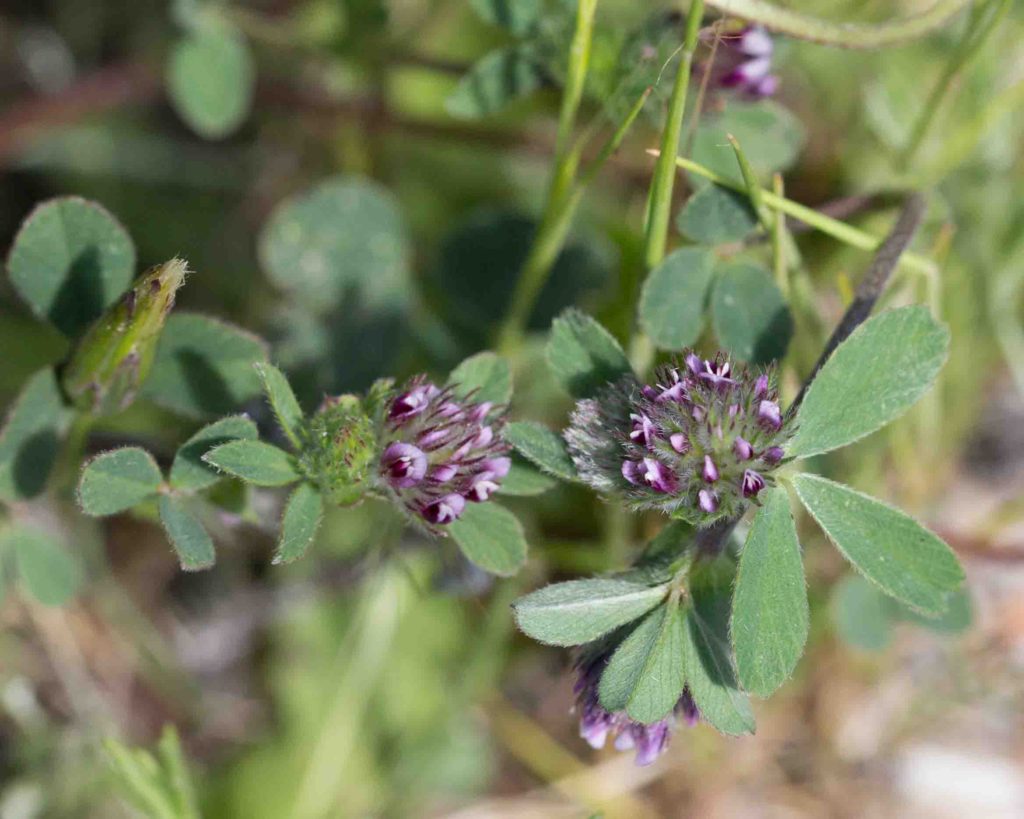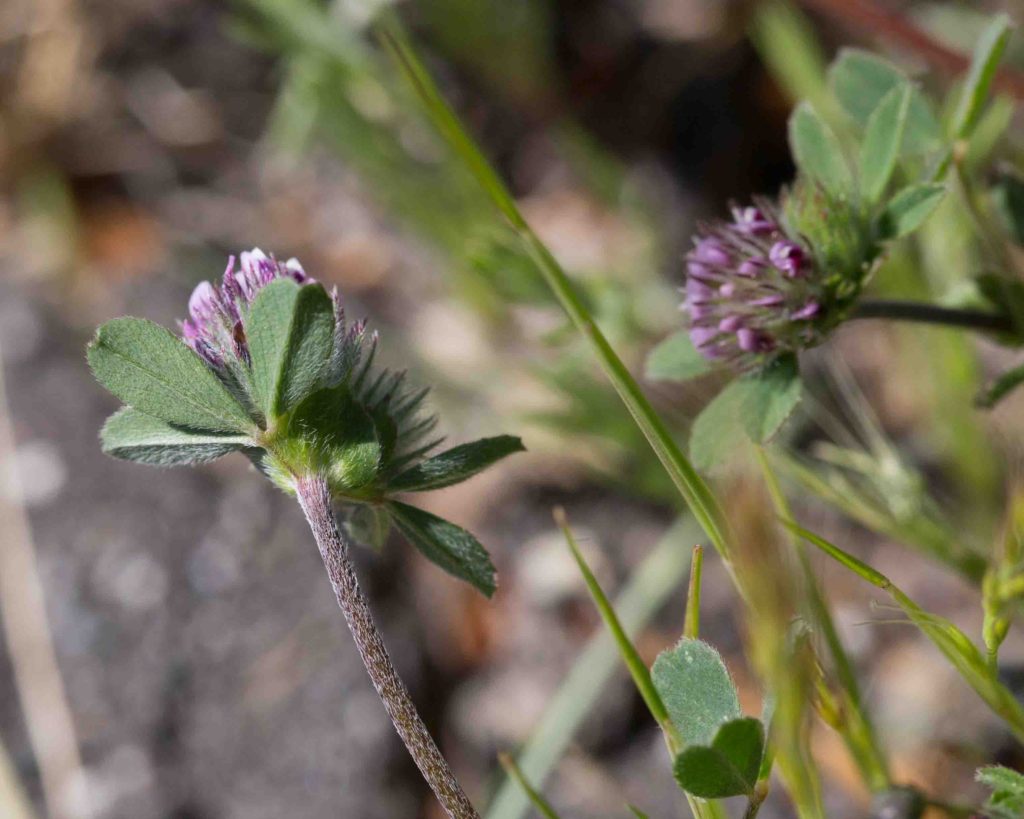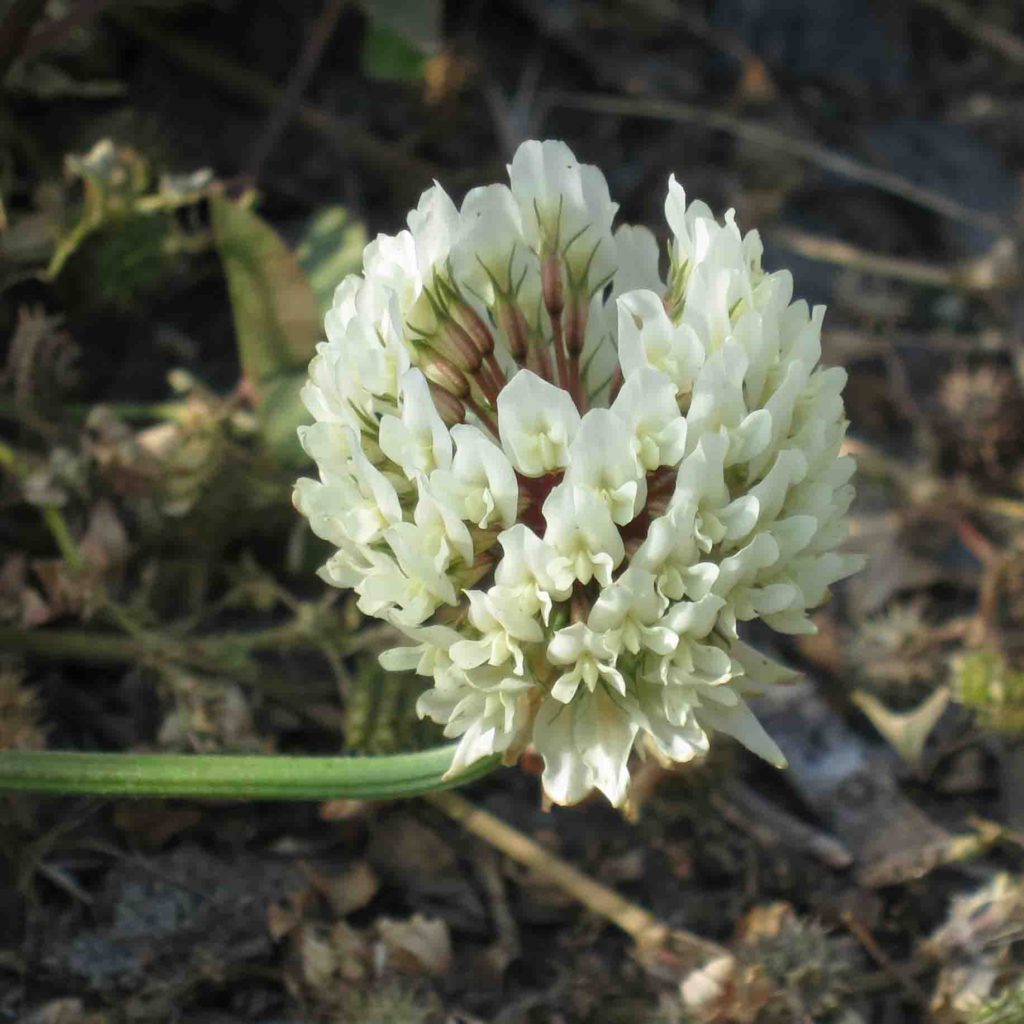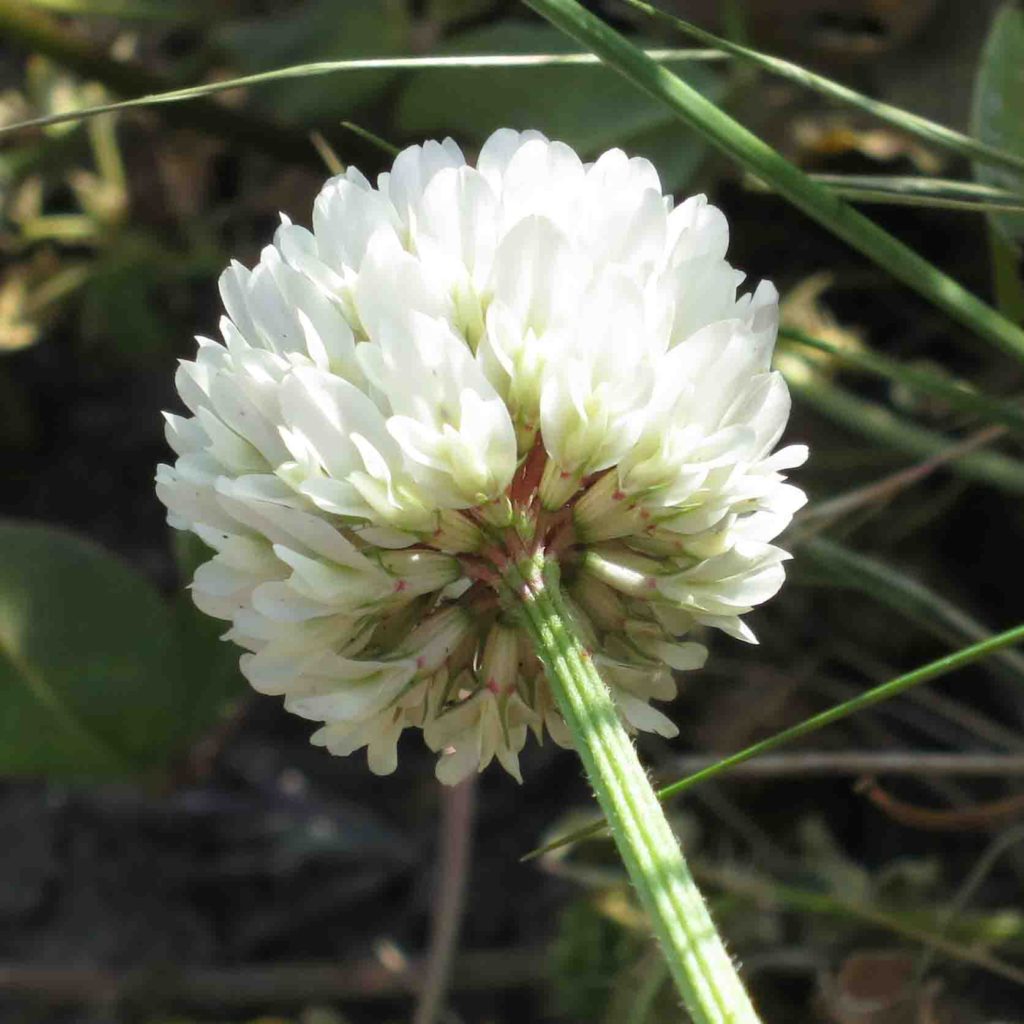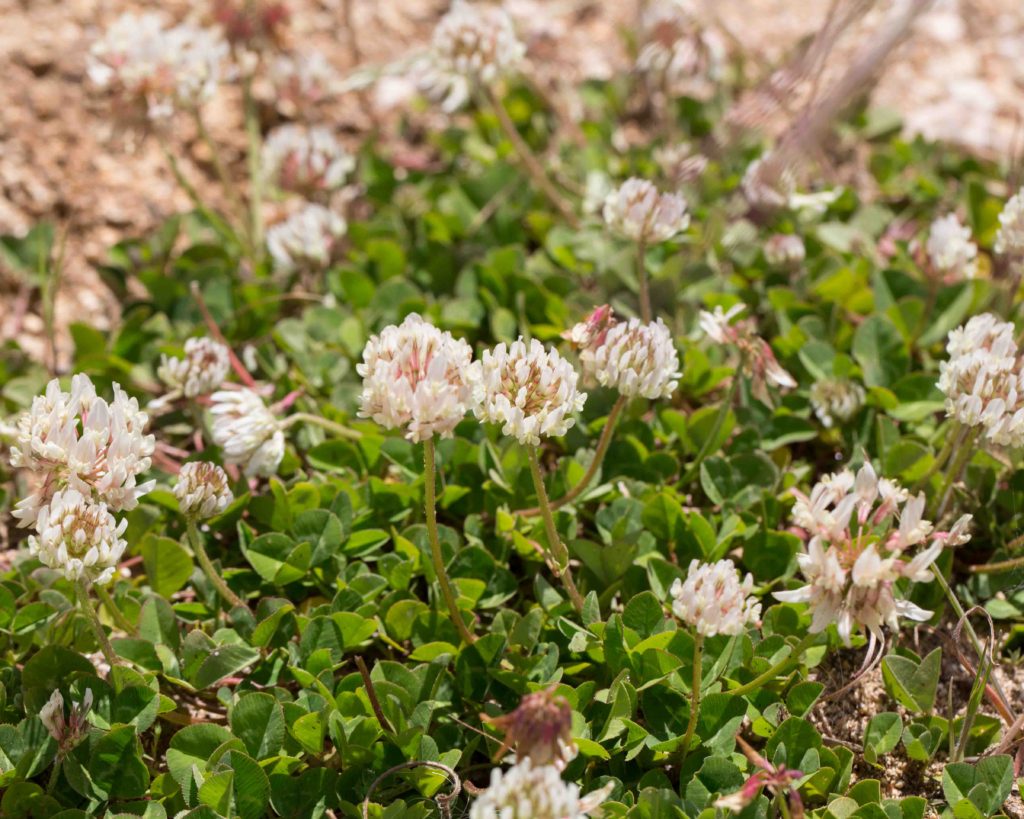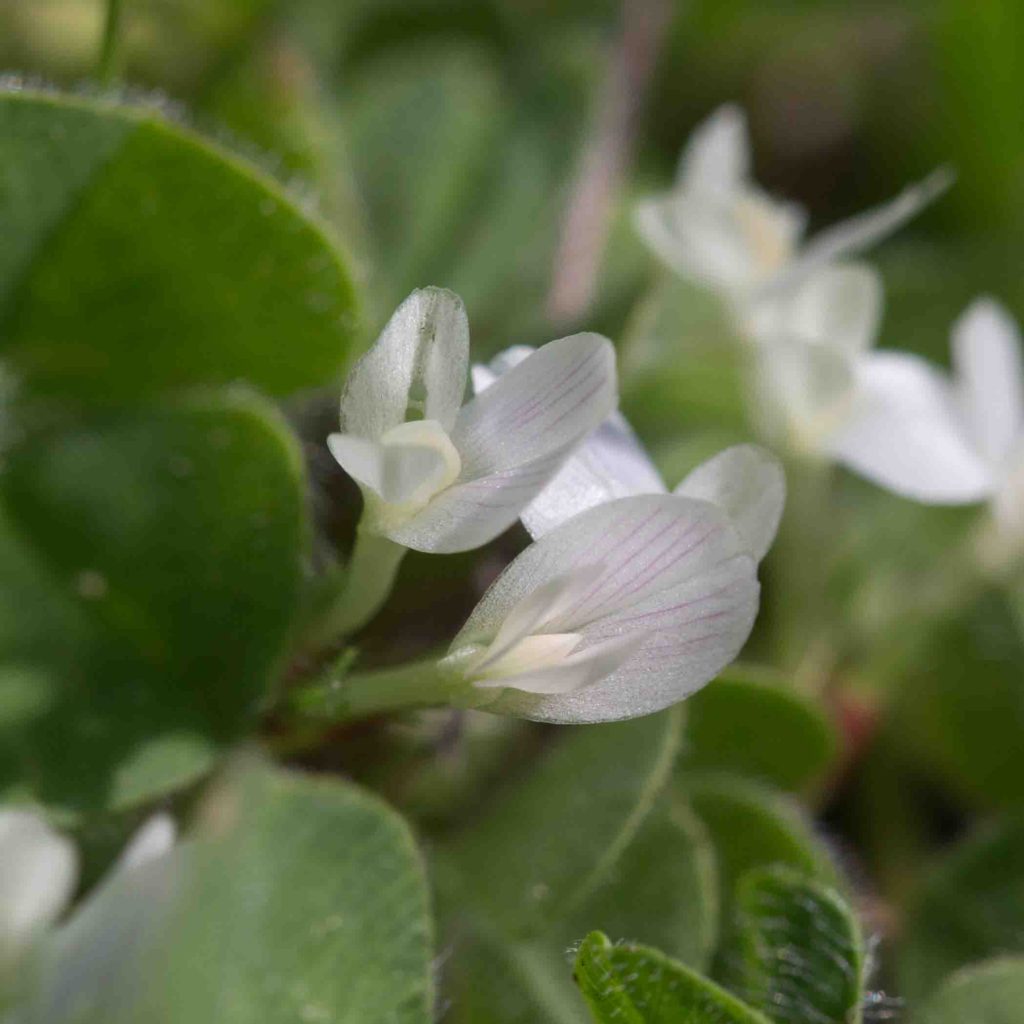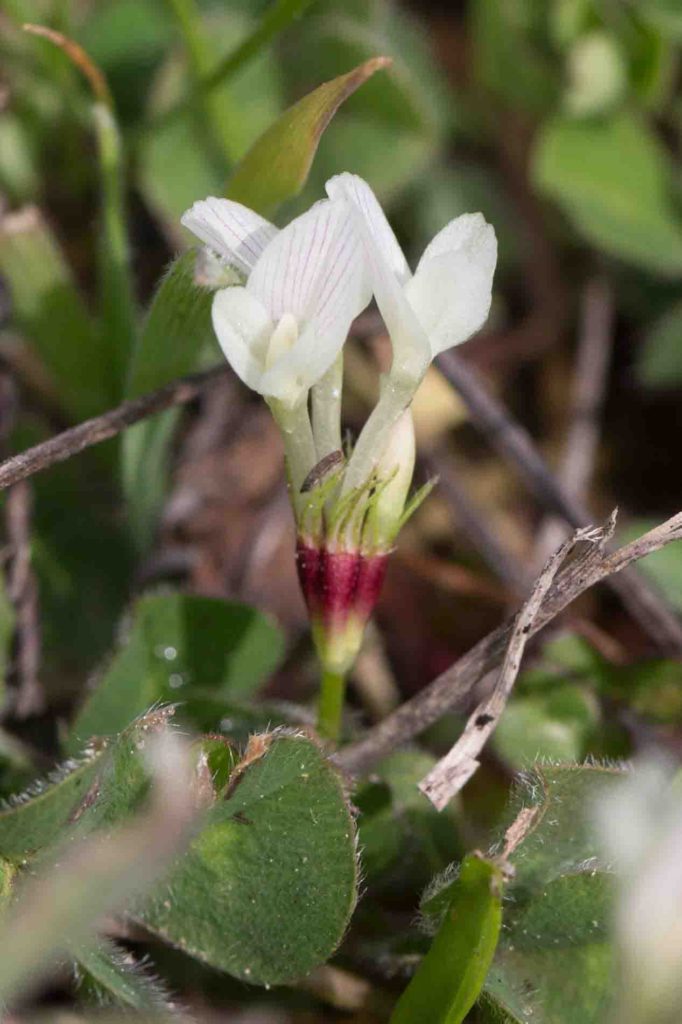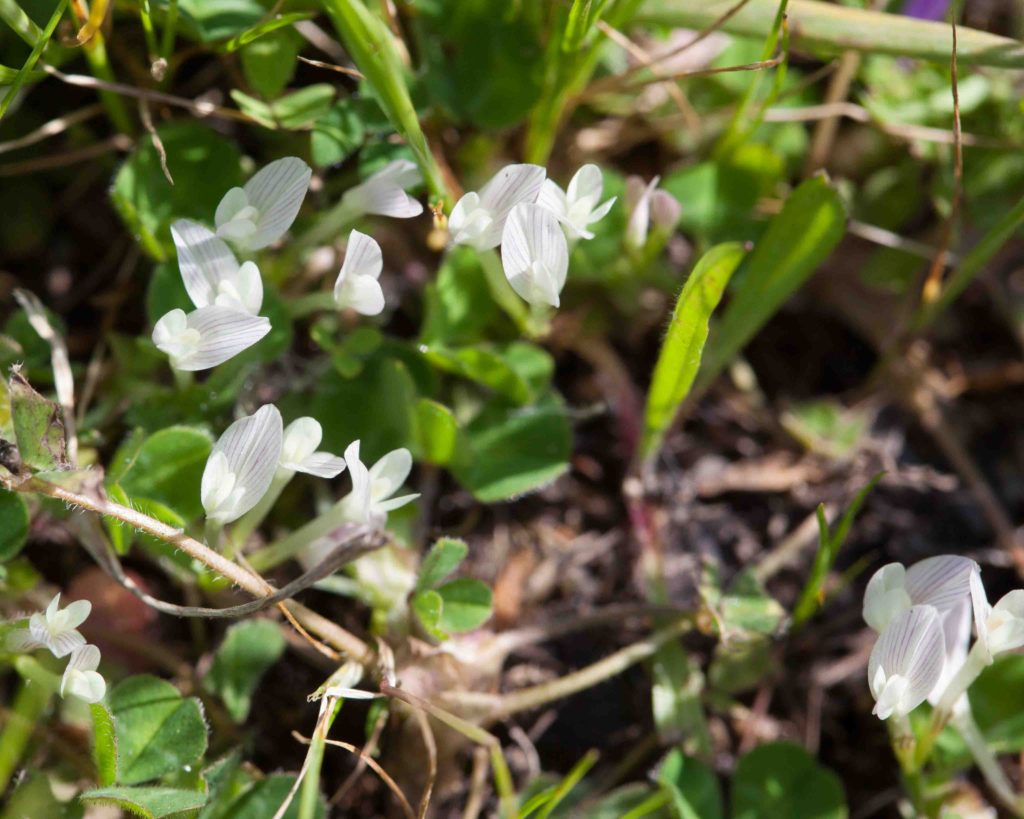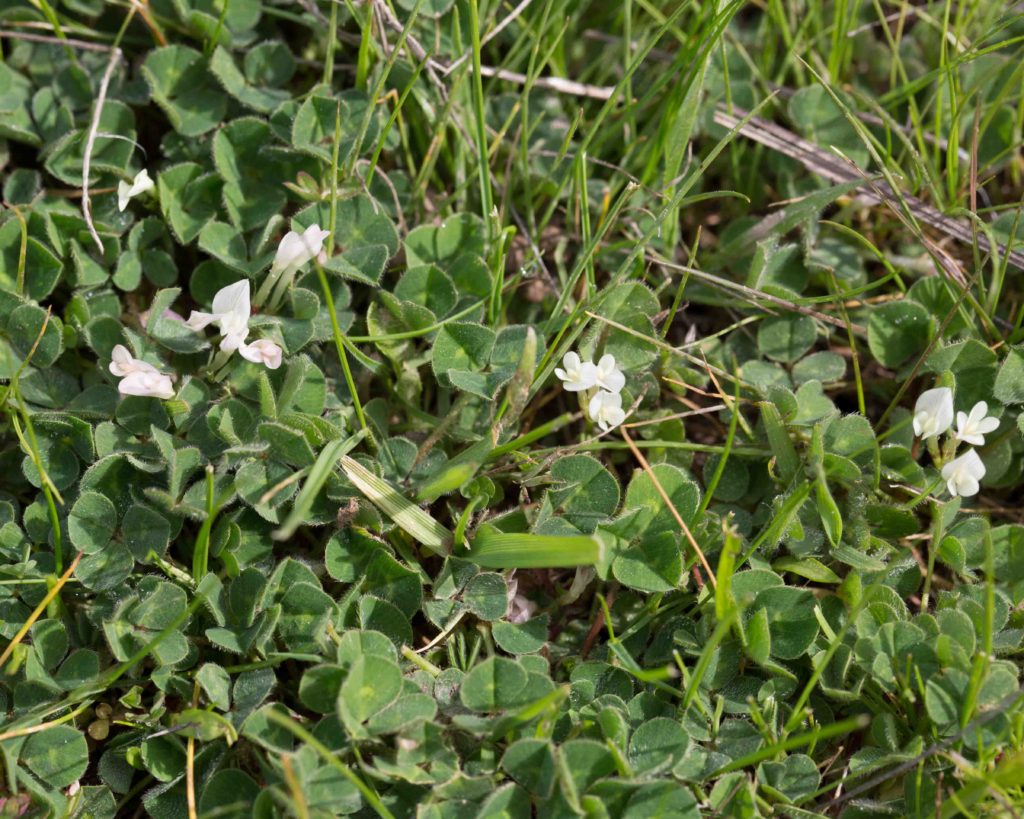Fabaceae: Pea Family — Trifolium (Clover): flower heads without involucre
The pea family has 5-petaled flowers, consisting of a wide upper banner petal, two wing petals, plus two lower petals which are fused to form a boat-shaped keel. Many produce heads or spikes, consisting of multiple individual flowers (examples are lupines and clovers). The seed pod is generally a “legume”. This is a long, flattish pod, swollen by the seeds, and splitting lengthwise along both the top and bottom.
Clovers are common, small plants, sometimes with subtle differences. In reading about a clover, remember that the flower head is made up of many small individual flowers. So if a description says that the calyx lobe is longer than the flower, examine the individual flower’s calyx. Identifying clovers is simplified by looking to see if they have an involucre: bracts at the base of the head which are fused to form a cup, bowl or wheel. This page covers the clovers that do not have an involucre; most are non-native.
Rancheria / Indian Clover – Trifolium albopurpureum
Blooms:
Mar–June
Plant Height:
Small
Flower Size:
Medium
Origin:
Native
Habitat:
Open grassy areas
Notes:
This small clover can appear in profusion. Flowers are noticeably woolly, purple with a pale pink tip, borne on long peduncles. Not to be confused with Rose Clover (Trifolium hirtum, see below), which has much larger pure pink flowers, subtended by 1 or 2 small leaves, each with several leaflets.
Narrow-leaved Clover – Trifolium angustifolium
Blooms:
May–June
Plant Height:
Medium
Flower Size:
Large
Origin:
Mediterranean
Habitat:
Open grassy areas
Notes:
An increasingly common clover, so much so that one clover expert remarked “here today, the world tomorrow”. Sometimes found in large quantities. It is distinguished by its tall, 1–5 cm cylindrical spike of pink flowers, which fade to orange after pollination. Its narrow, strappy leaflets are distinctive, 2–4.5 cm long. The calyx lobes are sharp-tipped, and harden in fruit, making the fruits quite prickly to the touch.
Rabbitfoot Clover – Trifolium arvense
Blooms:
June
Plant Height:
Medium
Flower Size:
Large
Origin:
Europe
Habitat:
Open grassy areas
Notes:
Similar to Narrow-leaved Clover (Trifolium angustifolium, see above), but with a smaller (1–3 cm) ovate to short-cylindric inflorescence. The calyx lobes are narrow and densely hairy, much longer than the pale pink to white flowers. This gives the inflorescence a distinctly bristly appearance, although it is very soft to the touch. Leaflets are less than 2 cm long, oblong to oblanceolate. Stipules are red-striped and similar to those of Rose Clover (Trifolium hirtum, see below), but narrower. Photo #2 by CJH.
Hop Clover – Trifolium campestre
Blooms:
April–May
Plant Height:
Small-medium
Flower Size:
Medium
Origin:
Europe
Habitat:
Open grassy & waste areas
Notes:
This and Shamrock Clover (Trifolium dubum, see below) are the only two yellow-flowered clovers found in the county; both are weedy immigrants from Europe. This has much larger flower heads (though still small), generally with 20 individual flowers. The banner has distinct veins. Photo #1 by CJH.
Tree / Foothill Clover – Trifolium ciliolatum
Blooms:
Mar–June
Plant Height:
Medium
Flower Size:
Medium
Origin:
Native
Habitat:
Open grassy areas
Notes:
This and Pinpoint Clover (Trifolium gracilentum, see below) are easily confused. Both have flowers that become reflexed as the inflorescence matures, as shown in the last two pictures. Also, both may exhibit the same “pinpoint” (the tip of the axis which becomes visible as the flowers reflex). This species is most easily distinguished by the short bristles on the calyx (the calyx of Pinpoint Clover is glabrous). Also, its leaflets are longer (1–2 cm) and more slender.
Shamrock / Little Hop Clover – Trifolium dubium
Blooms:
May–July
Plant Height:
Small
Flower Size:
Small
Origin:
Europe
Habitat:
Open grassy & waste areas
Notes:
This and Hop Clover (Trifolium campestre, see above) are the only two yellow-flowered clovers found in the county; both are weedy immigrants from Europe. This has much smaller, distinctive flower heads, with 5–10 individual flowers arranged in umbels. Leaflets are obovate and finely toothed.
Strawberry Clover – Trifolium fragiferum
Blooms:
Mar–Aug
Plant Height:
Small
Flower Size:
Small
Origin:
Europe, Africa
Habitat:
Escape from cultivation, disturbed areas
Notes:
This clover is unusual because of the appearance of the fruiting body. The flower head is unremarkable, about 1 cm across, with pale pink flowers subtended by green involucral bracts which remain free. As the flowers mature, the calyxes inflate so that the fruiting head is said to resemble a strawberry, though somewhat fuzzier than the real thing. Also, it’s a little pricklier, because of the two bristle-like calyx lobes extending below the opening of each inflated calyx.
Clustered Clover – Trifolium glomeratum
Blooms:
Mar–May
Plant Height:
Small
Flower Size:
Small
Origin:
Europe
Habitat:
Disturbed areas
Notes:
Uncommon, but can spread rapidly once it becomes established. The flower heads are sessile, either at the stem tip or in leaf axils. Individual flowers are pale pink, each with a calyx comprising a pair of triangular sepals with recurved tips. Leaflets are about 1 cm long and obovate.
Pinpoint Clover – Trifolium gracilentum
Blooms:
Mar–June
Plant Height:
Medium
Flower Size:
Medium
Origin:
Native
Habitat:
Open disturbed, dry or moist areas
Notes:
This and Tree Clover (Trifolium ciliolatum, see above) are easily confused. Both have flowers that become reflexed as the inflorescence matures, as shown in the first and last pictures. Also, both may exhibit the same “pinpoint” (the tip of the axis which becomes visible as the flowers reflex). This species is most easily distinguished by its glabrous calyx (the calyx of Tree Clover is clearly bristly). Its leaflets are smaller (< 1.5 cm) and broader, with a shallowly notched tip. Photos #3-4 by CJH.
Rose Clover – Trifolium hirtum
Blooms:
Apr–May
Plant Height:
Medium
Flower Size:
Medium
Origin:
Eurasia
Invasive?
Yes – limited
Habitat:
Disturbed areas, roadsides
Notes:
This is thee only invasive non-native clover, and is often found in great quantities. The flowers are attractive, distinctly hairy, and pale to dark pink. The inflorescence is typically subtended by 1 or 2 leaves, each with 2 or 3 leaflets. Each petiole is subtended by a broad, pink-striped stipule. Photos #2-4 by CJH.
Crimson Clover – Trifolium incarnatum
Blooms:
May–Aug
Plant Height:
20–50 cm
Flower Size:
Large
Origin:
Europe
Habitat:
Fields and waste places
Notes:
The brilliant crimson inflorescence spikes of this clover are unmistakable. Individual flowers are longer than the calyx lobes. Despite the name, this species occasionally has white flowers.
Macrae’s Double-headed Clover – Trifolium macraei
Blooms:
Mar–May
Plant Height:
Small
Flower Size:
Small
Origin:
Native
Habitat:
Grassy places near coast, dunes
Notes:
A low-growing clover with decumbent to erect stems. It is most easily recognized by its paired heads, generally sessile but sometimes with one head on a short peduncle. Individual heads are < 1 cm across with purple or bicolored flowers. The calyx is hairy and subtended by one leaf with 3 leaflets. Leaflets are narrowly elliptic to ovate, 1–2 cm long.
White Clover – Trifolium repens
Blooms:
Feb–Dec
Plant Height:
Medium
Flower Size:
Large
Origin:
Eurasia
Habitat:
Escape from cultivation, moist areas or grassland
Notes:
This is often found as a lawn weed. Its pure white flowers, with their long flowering season, are easily recognized. The plant has creeping stems that root at the nodes, unlike Alsike Clover (Trifolium hybridum), which also has pure white flowers but with a sprawling to erect growth habit.
Subterranean Clover – Trifolium subterraneum
Blooms:
Mar–Apr
Plant Height:
Prostrate
Flower Size:
Small
Origin:
Southern Europe, North Africa
Habitat:
Meadows, roadsides
Notes:
This is an unusual clover, since it has flowers of two kinds. The outer flowers, rather lotus-like in appearance, are white with pink veins, and a distinct maroon ring at the base of the calyx lobes. These are fertile. In addition, it has sterile flowers which lack petals, and have a stalk-like calyx with bristles at their tips, which recurve to form a kind of bur. Close examination is needed to discern these.
